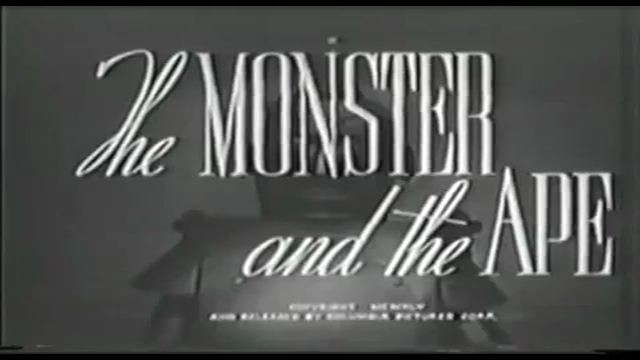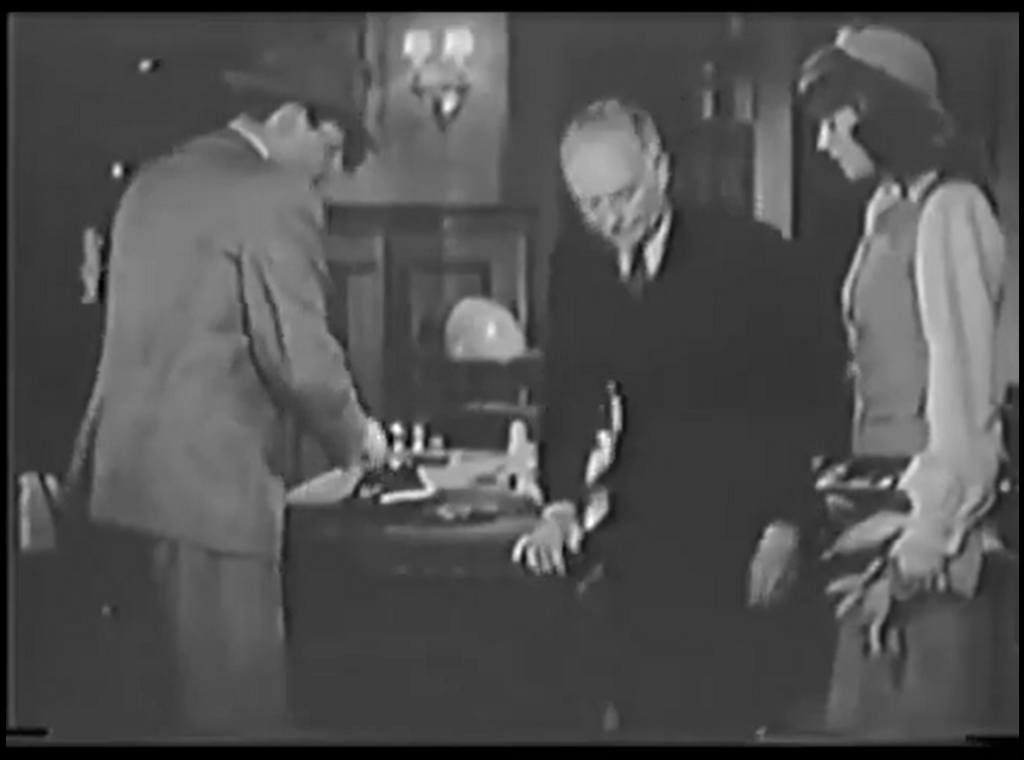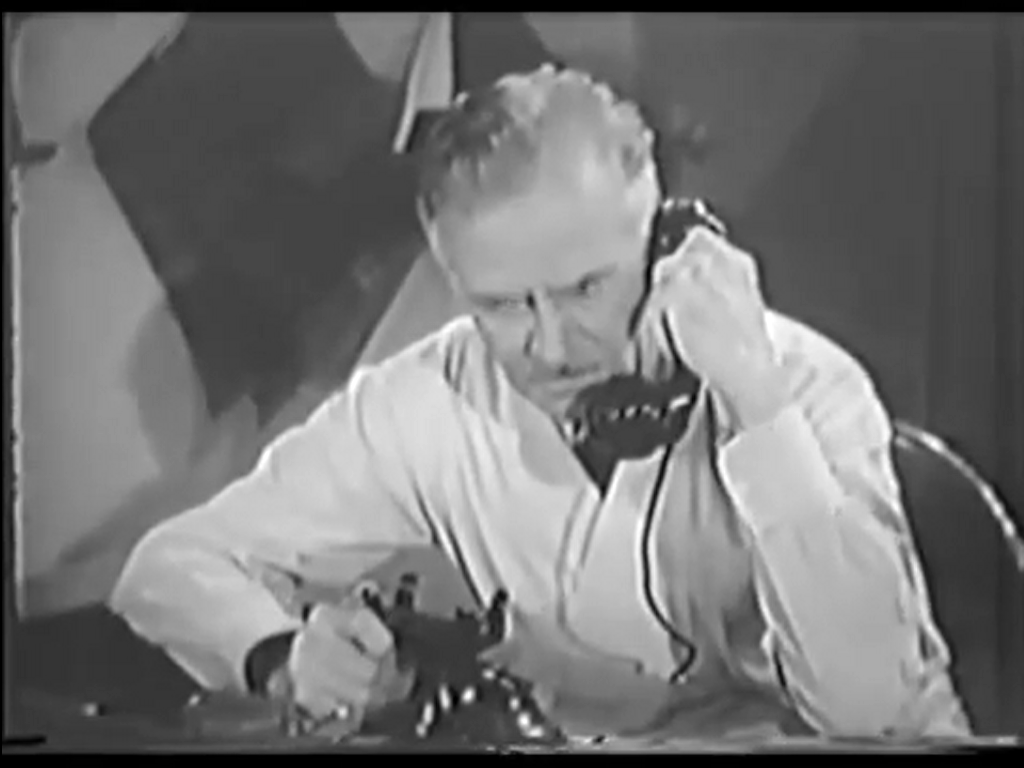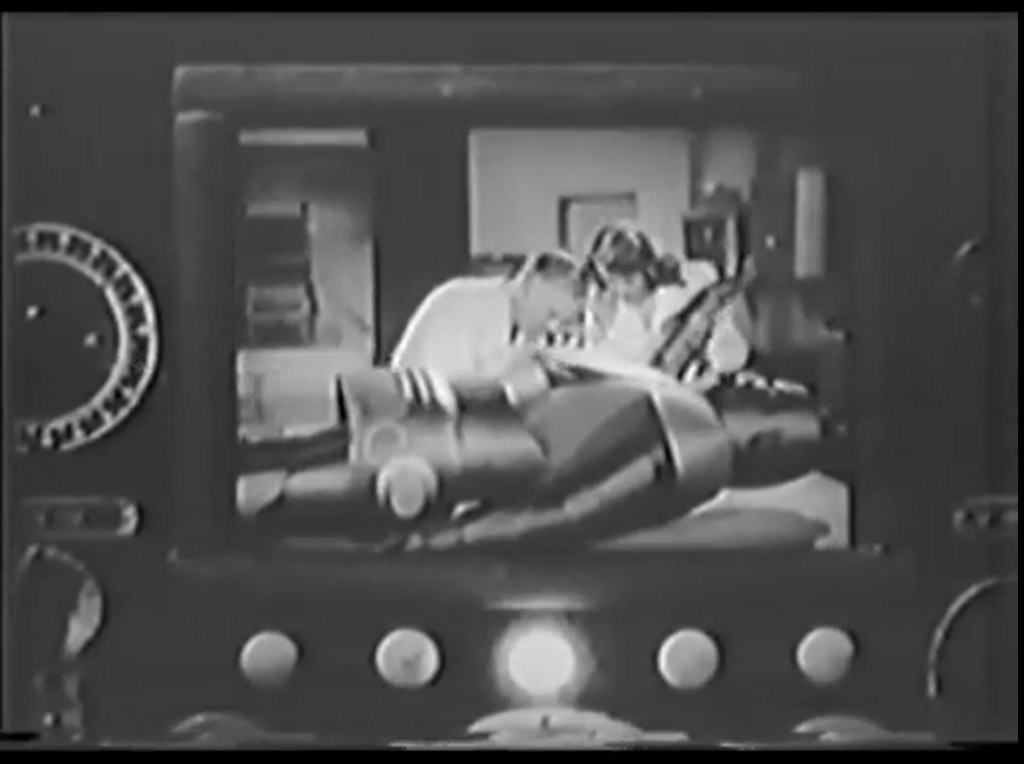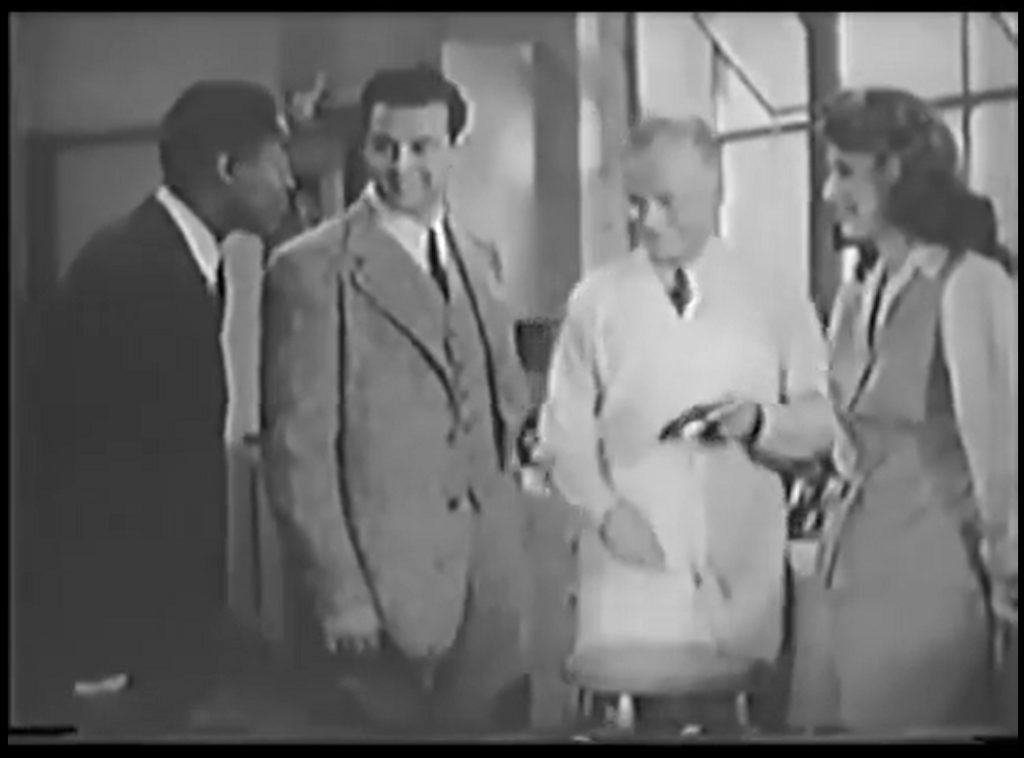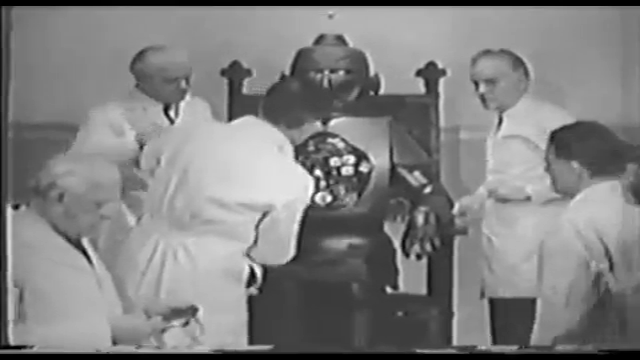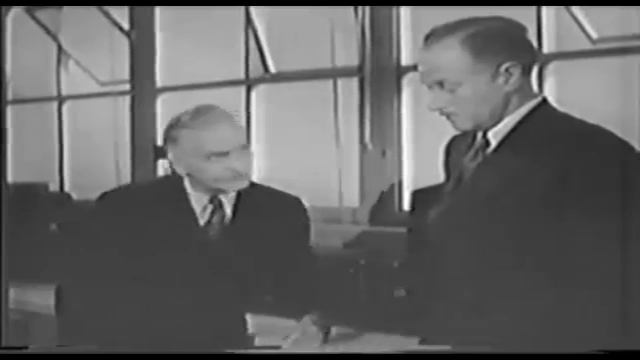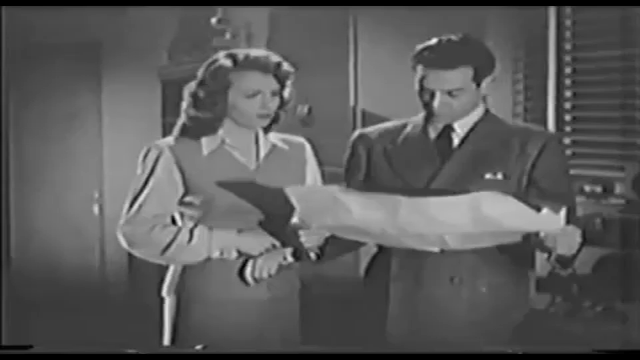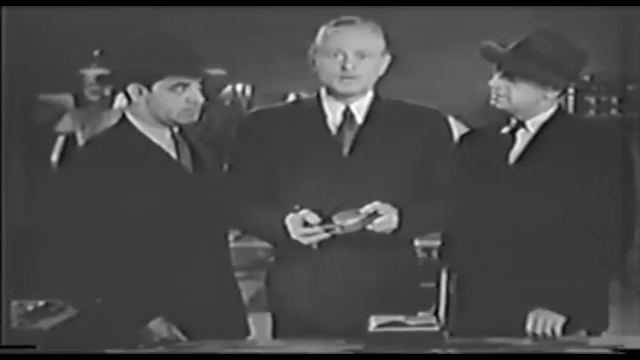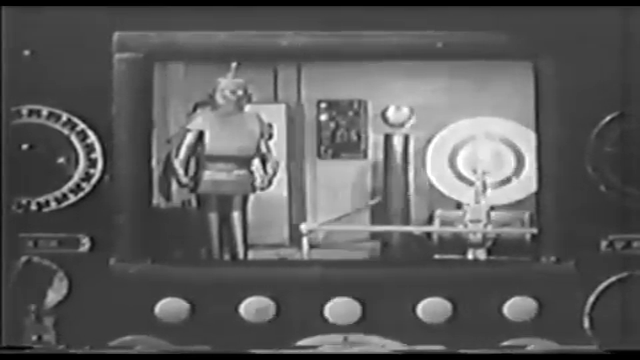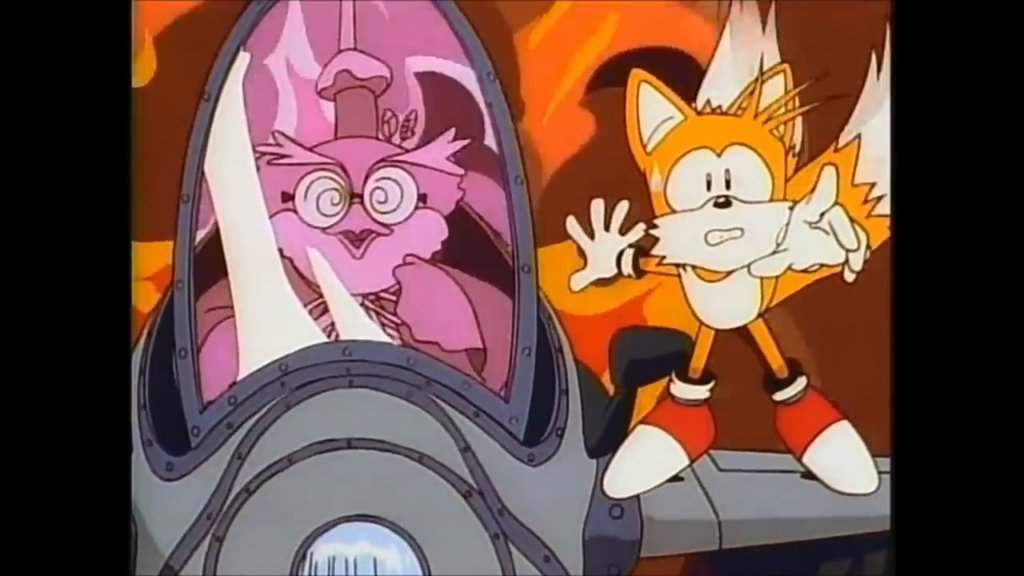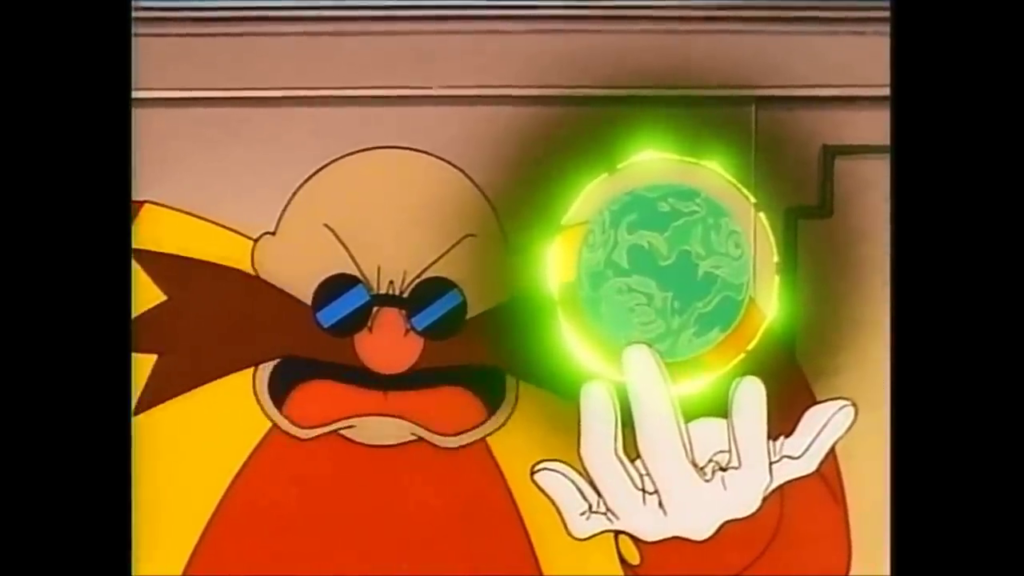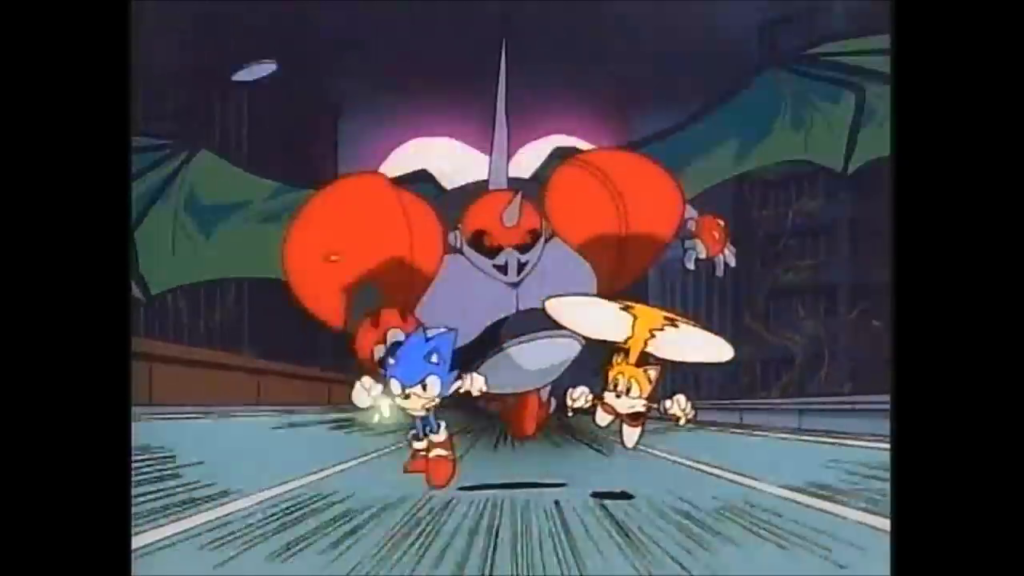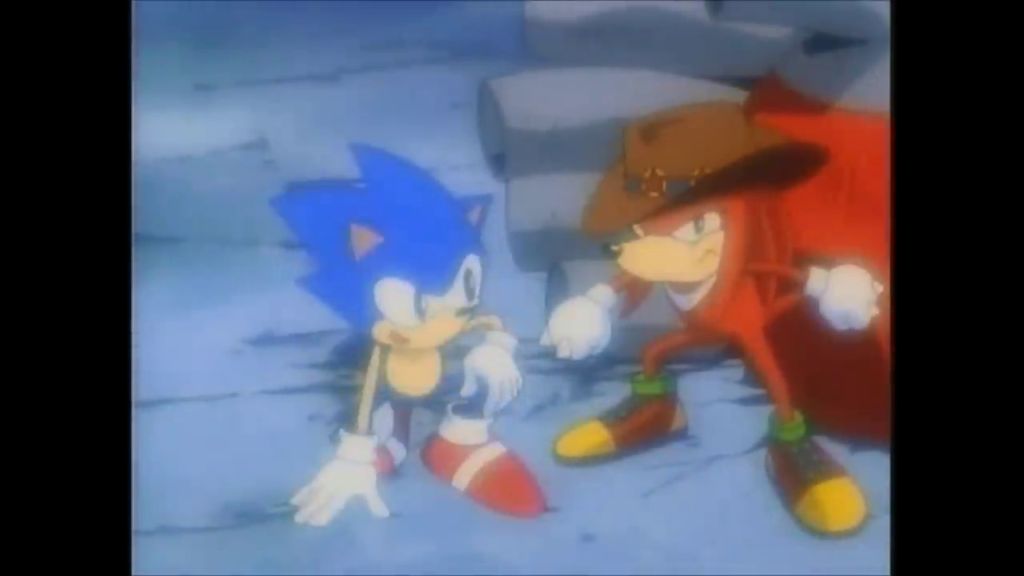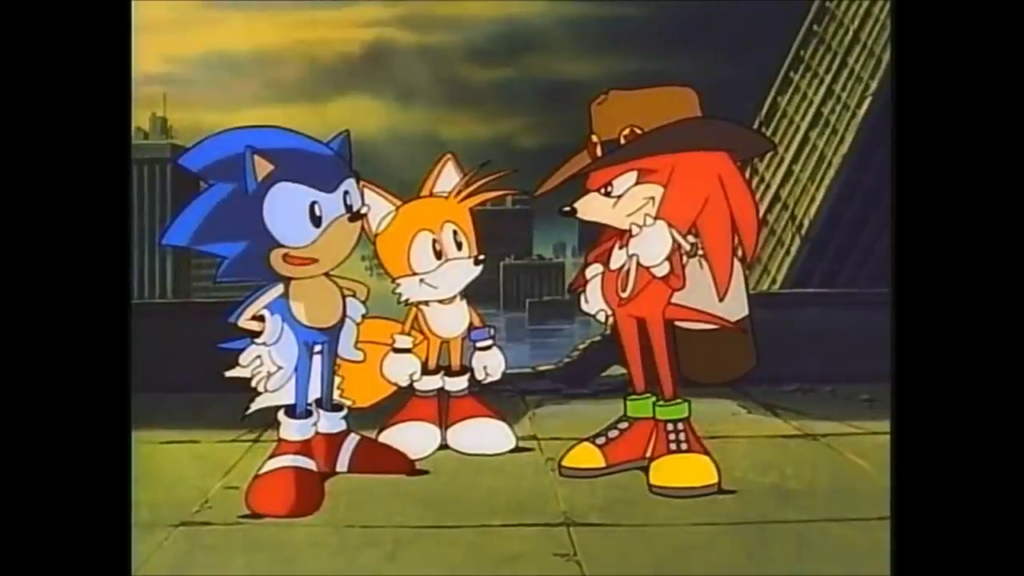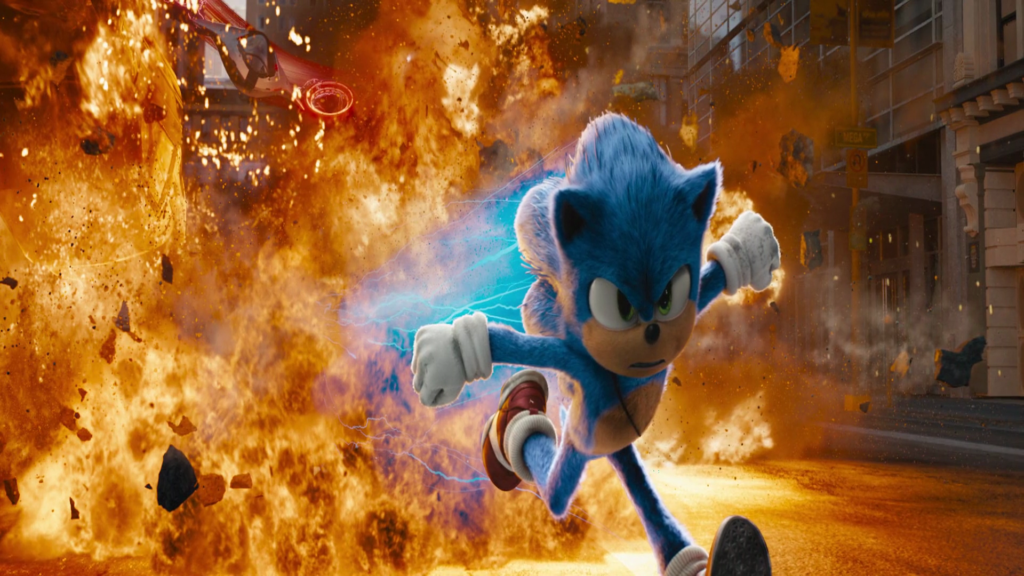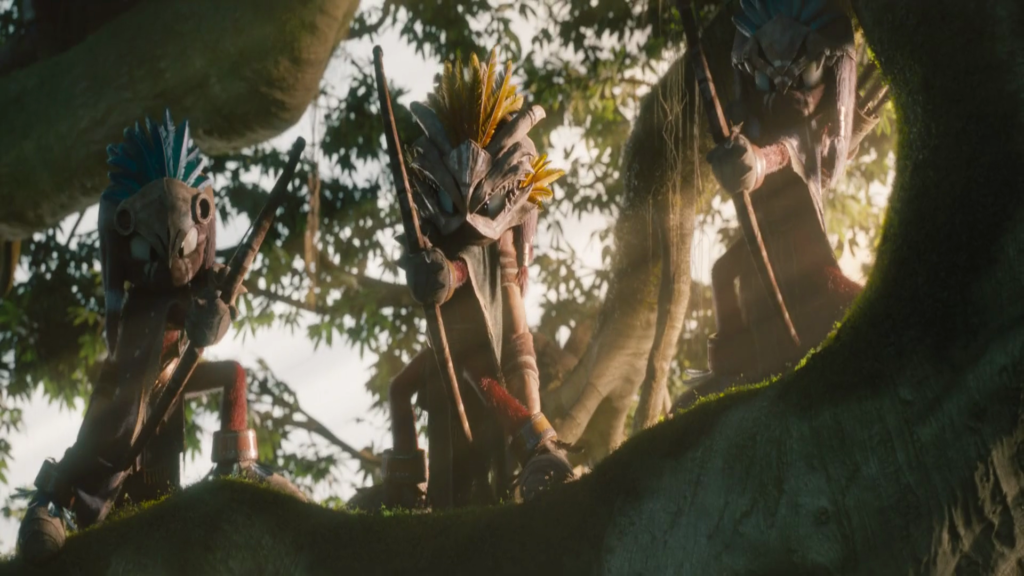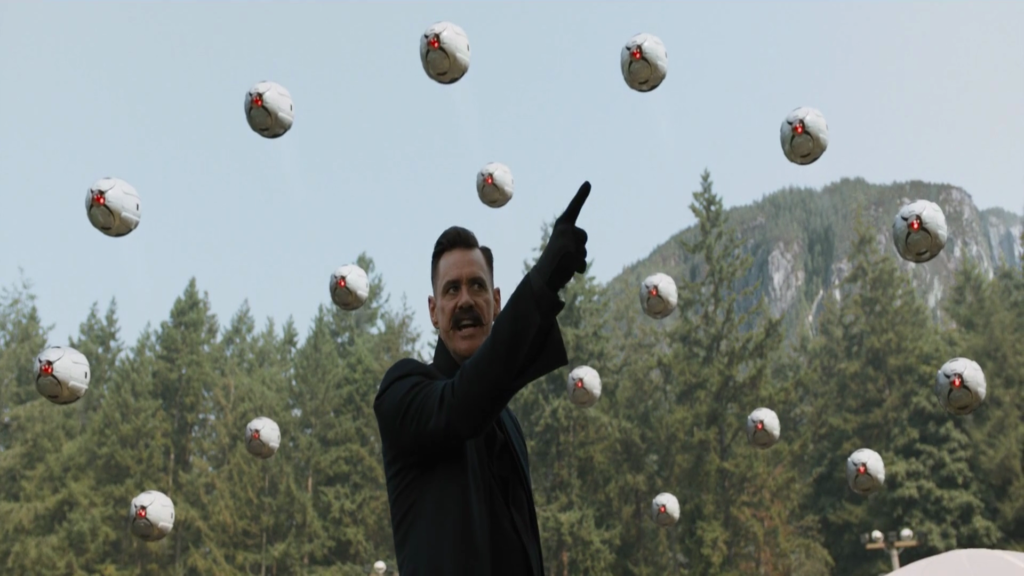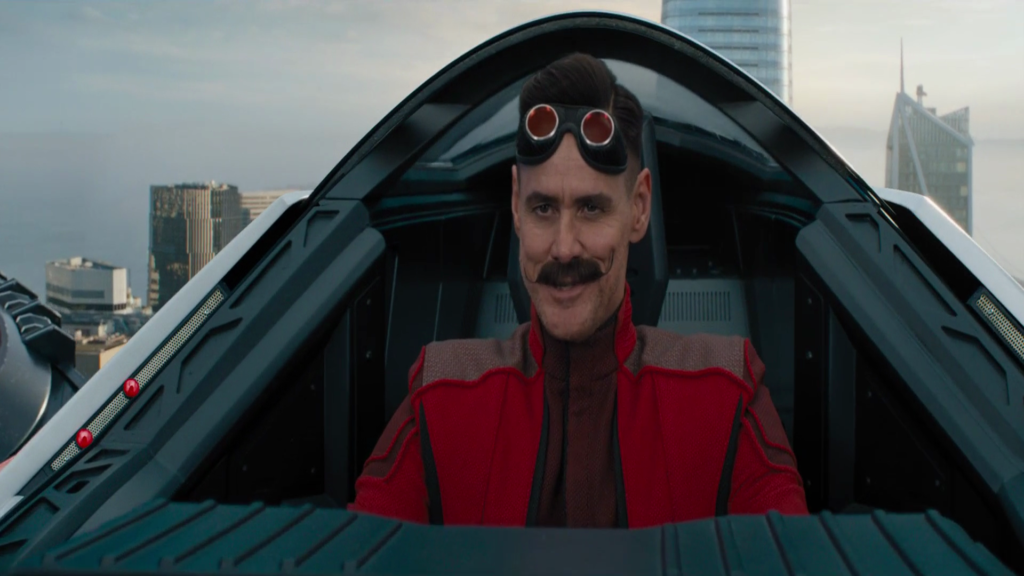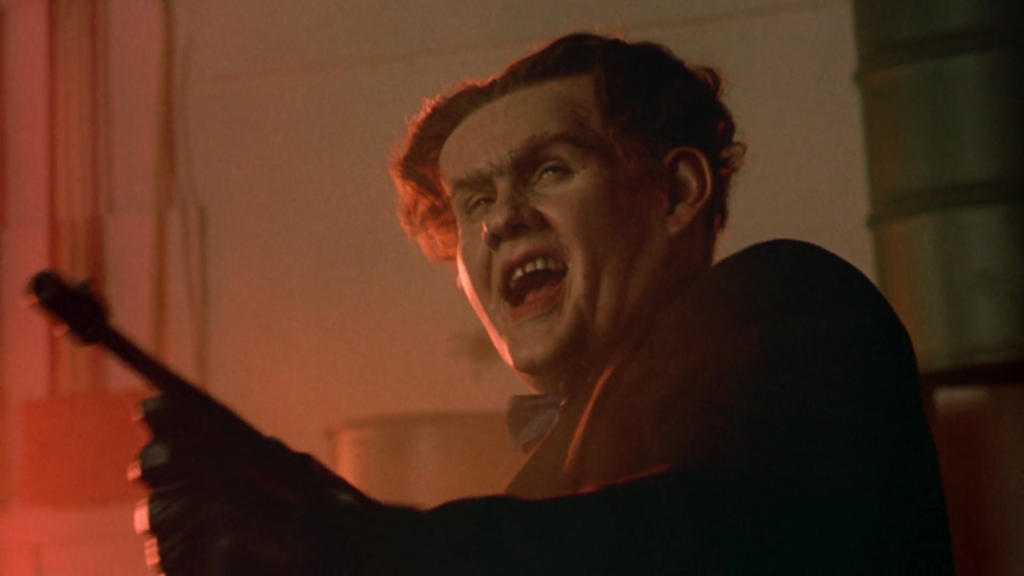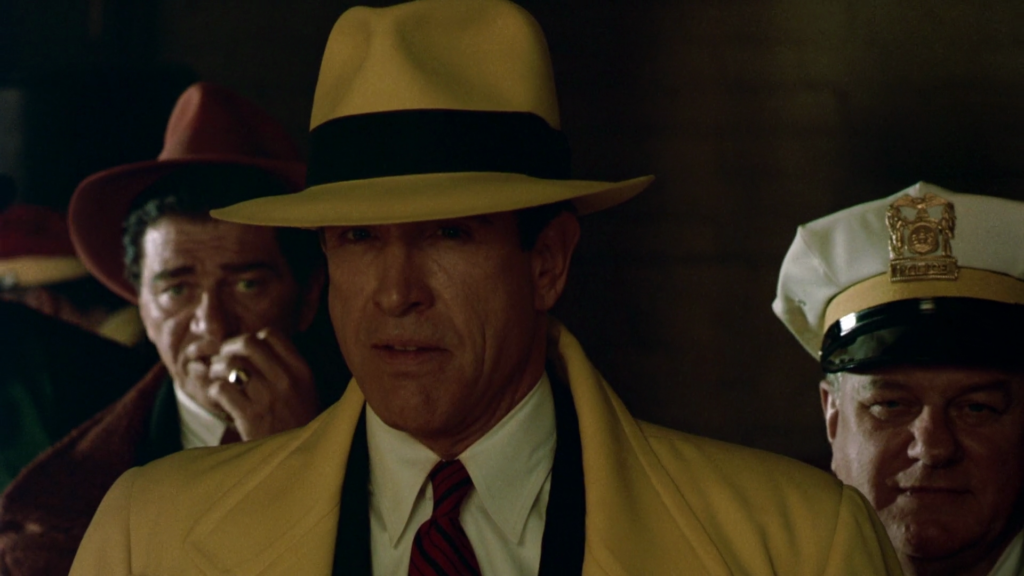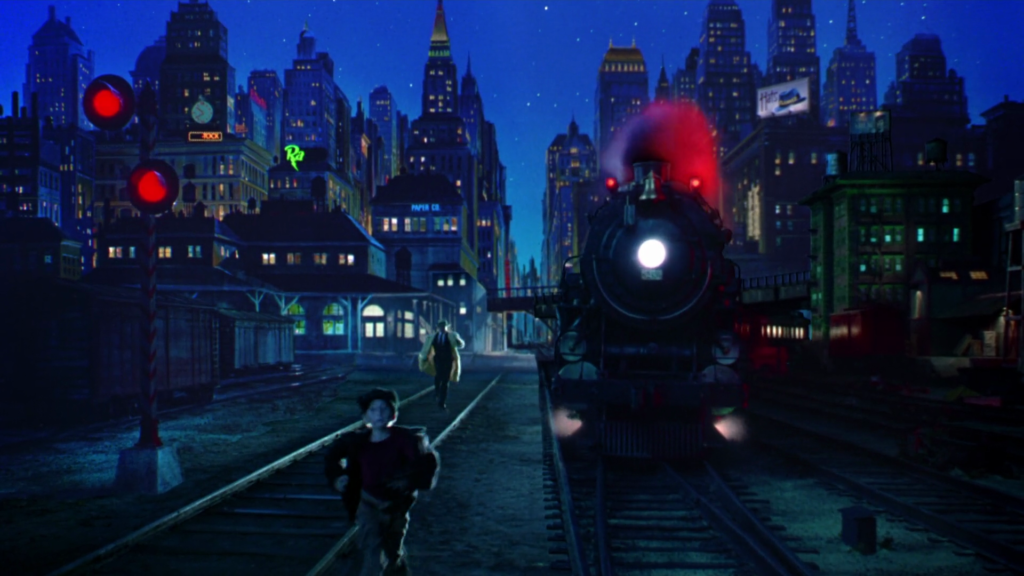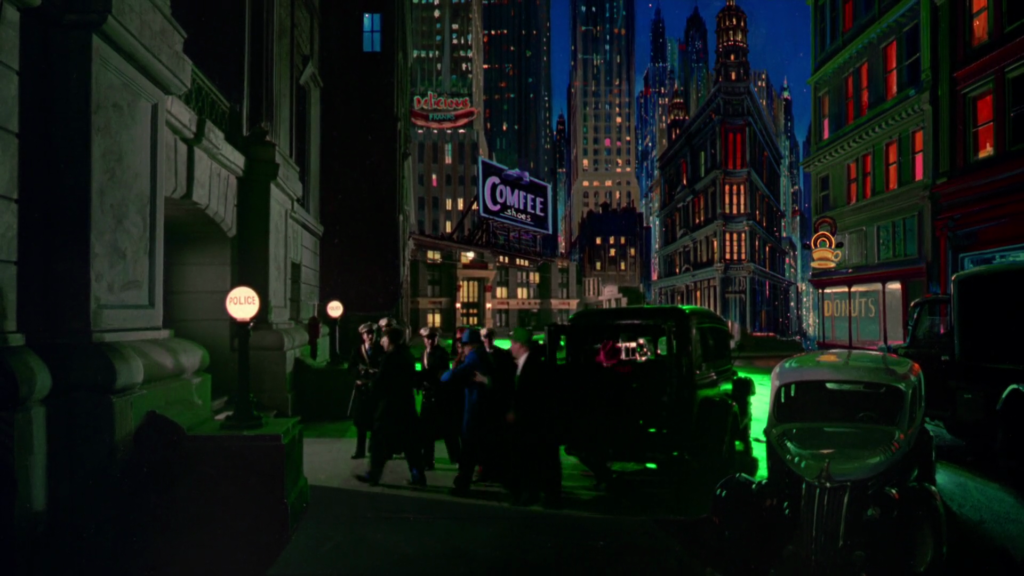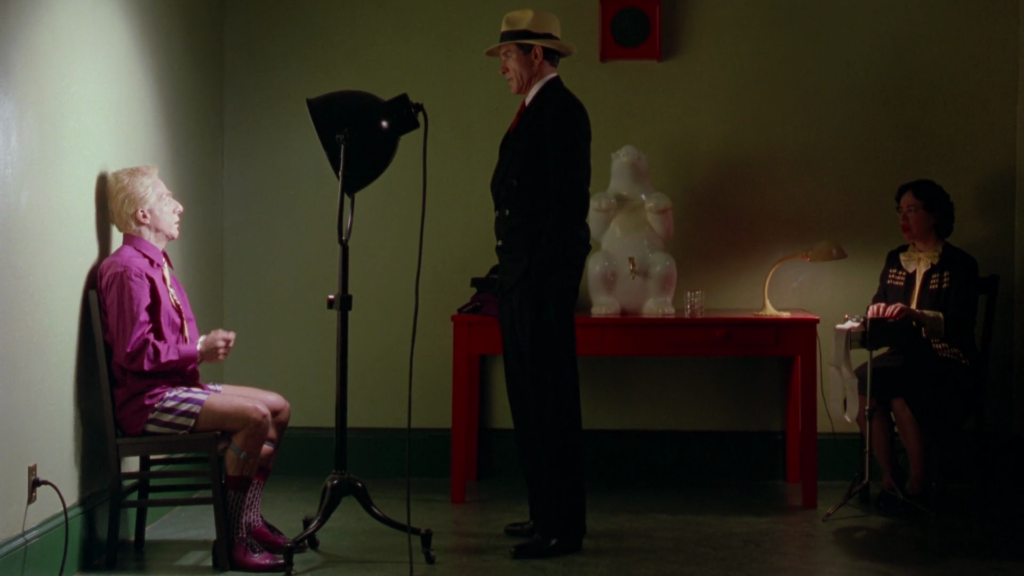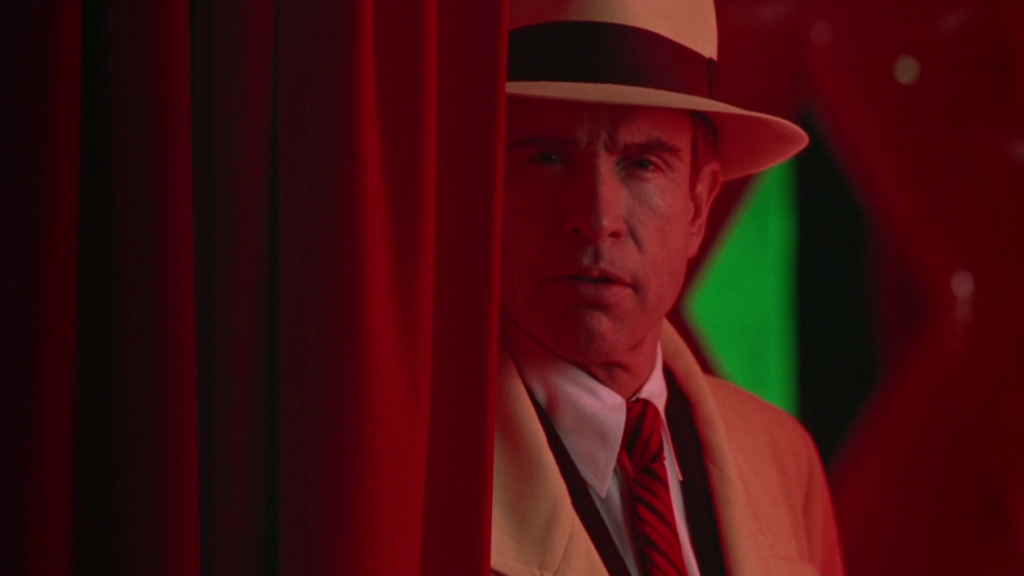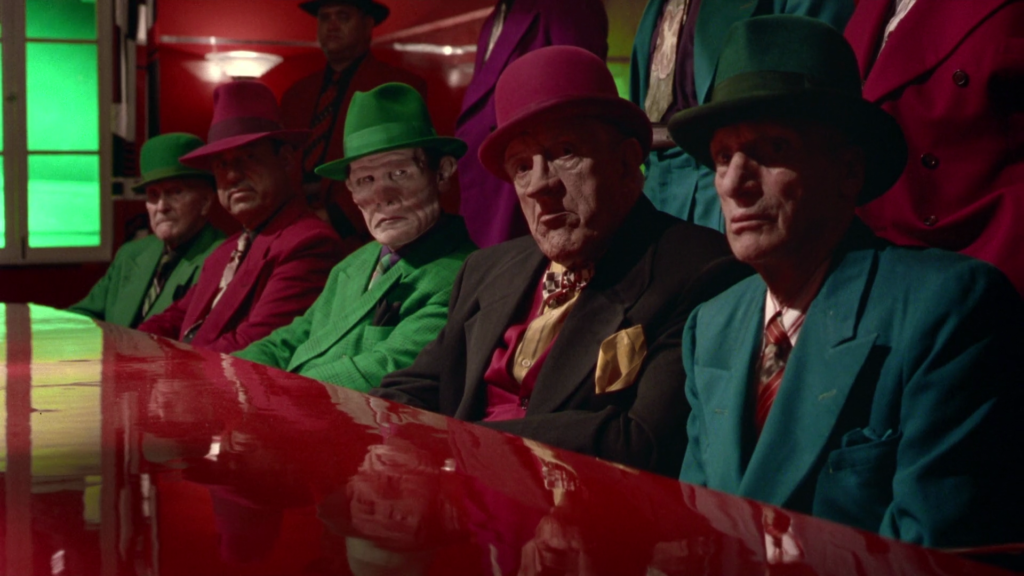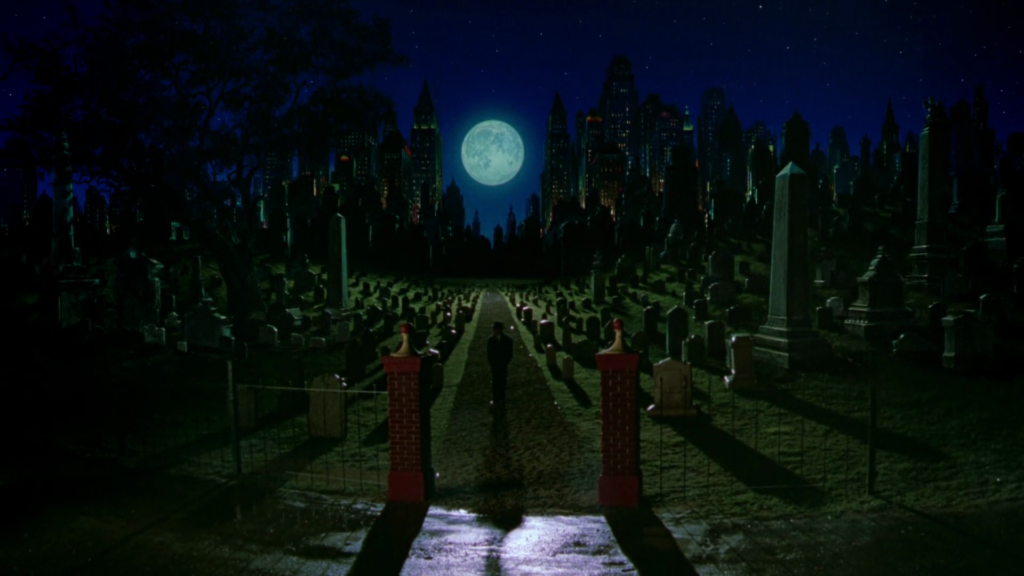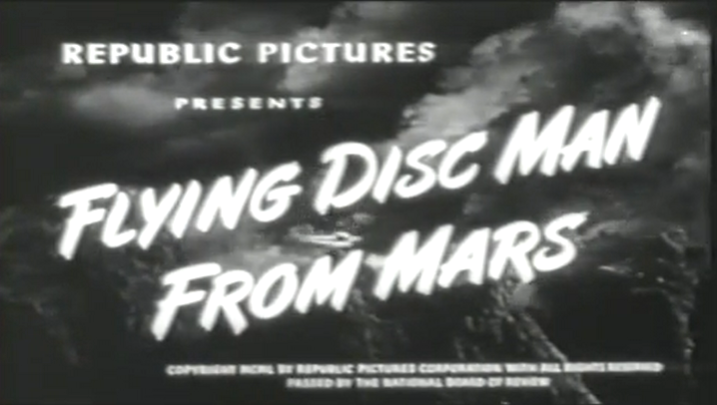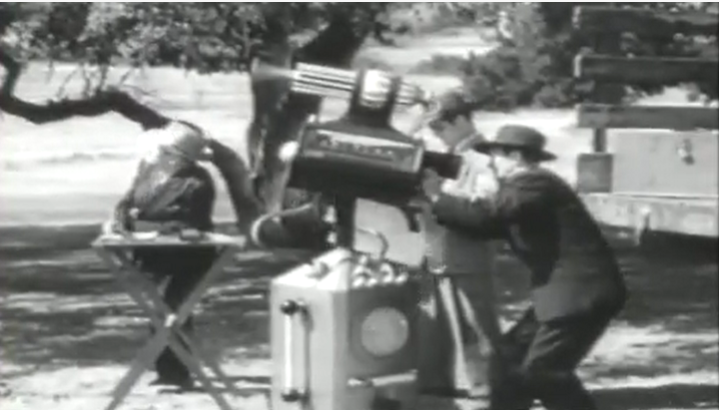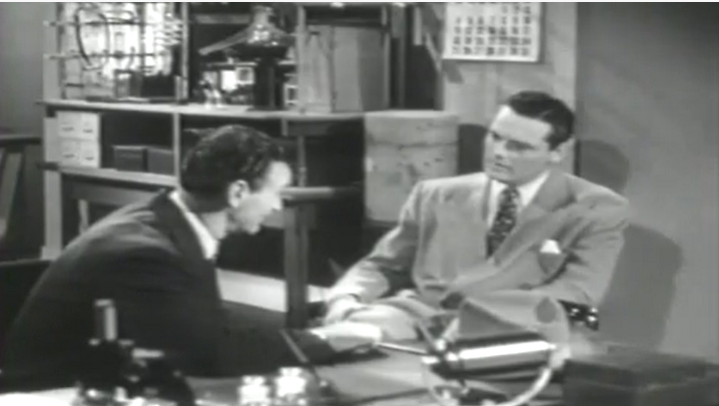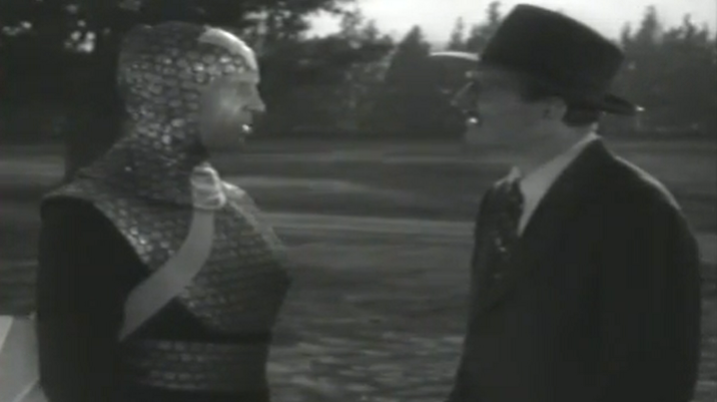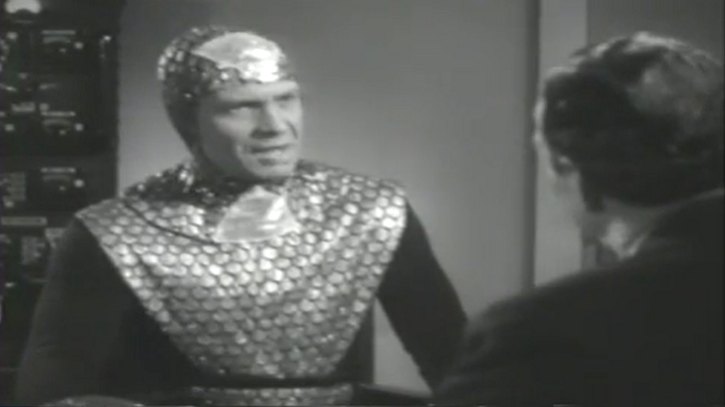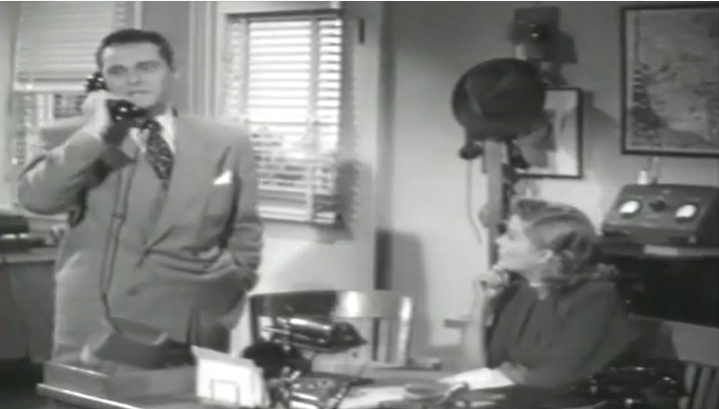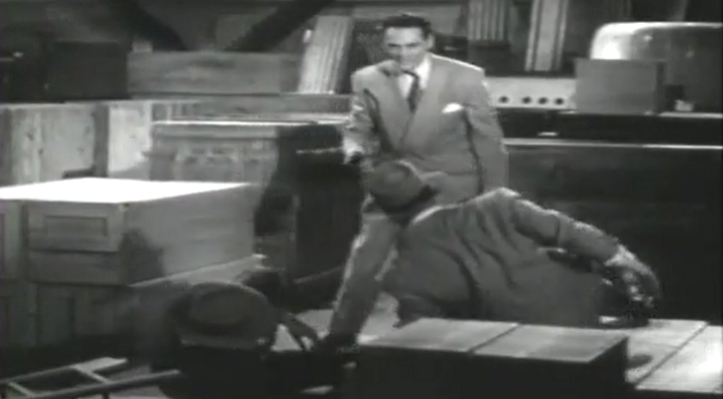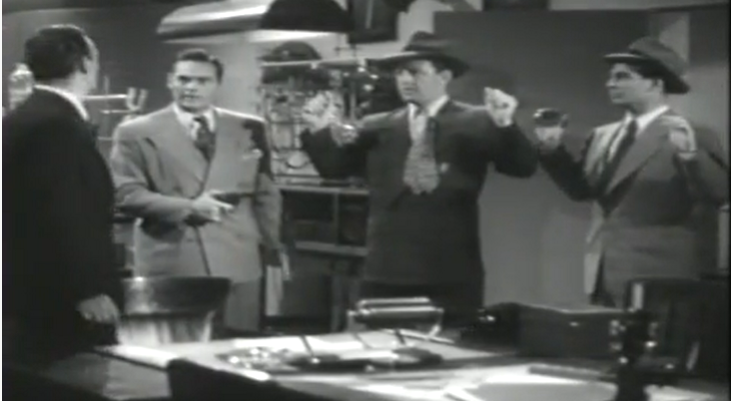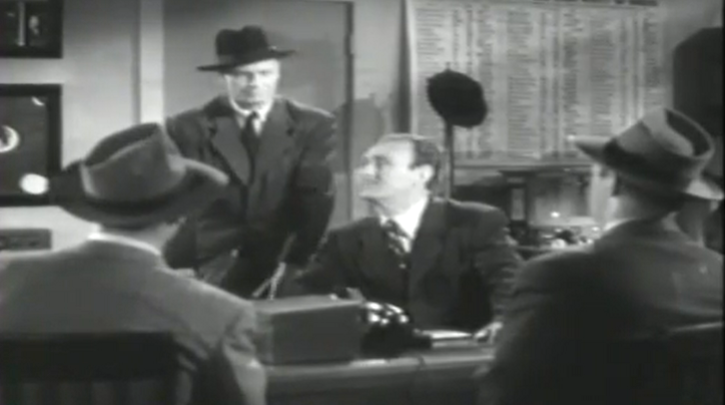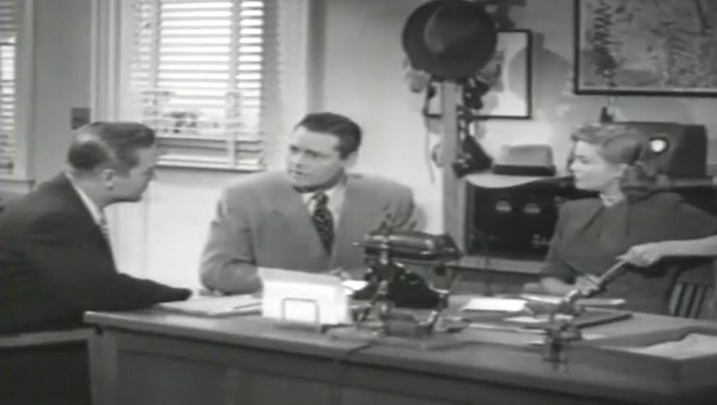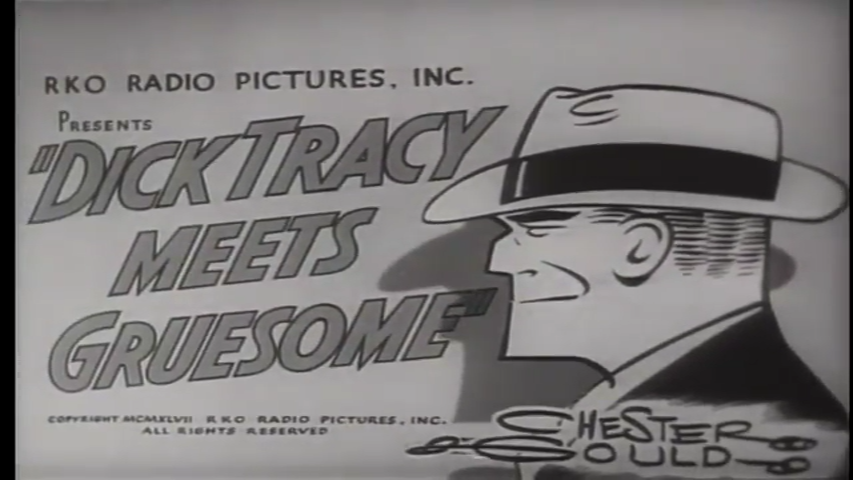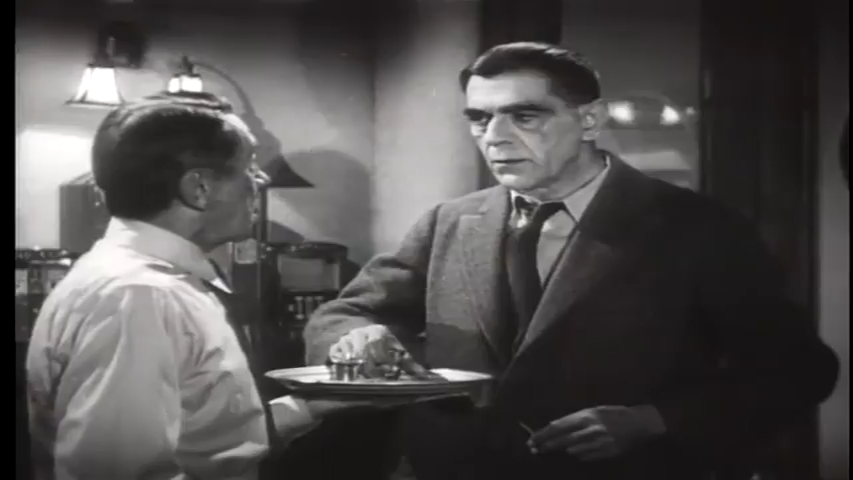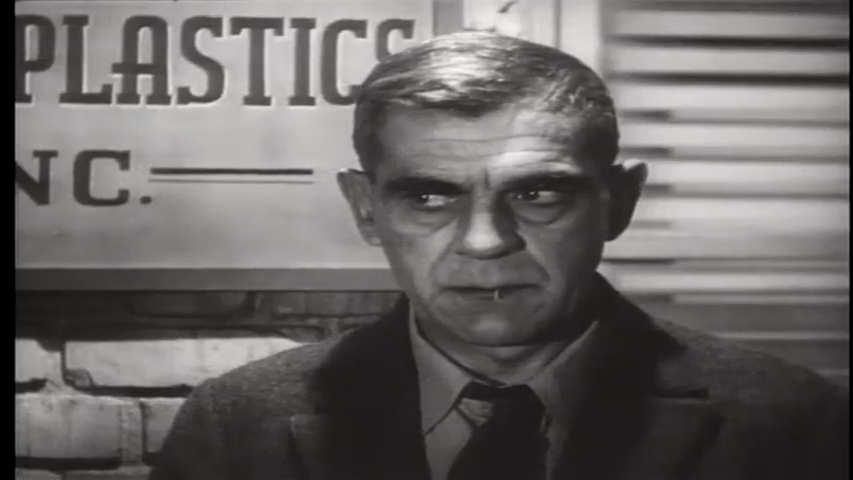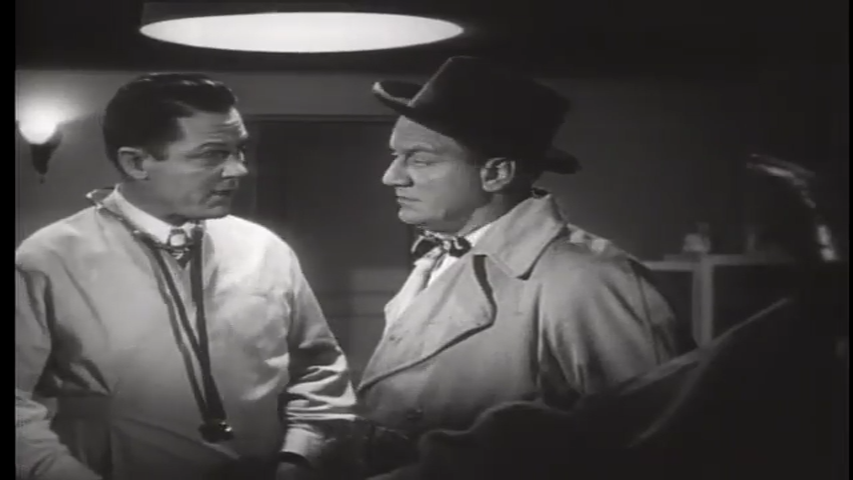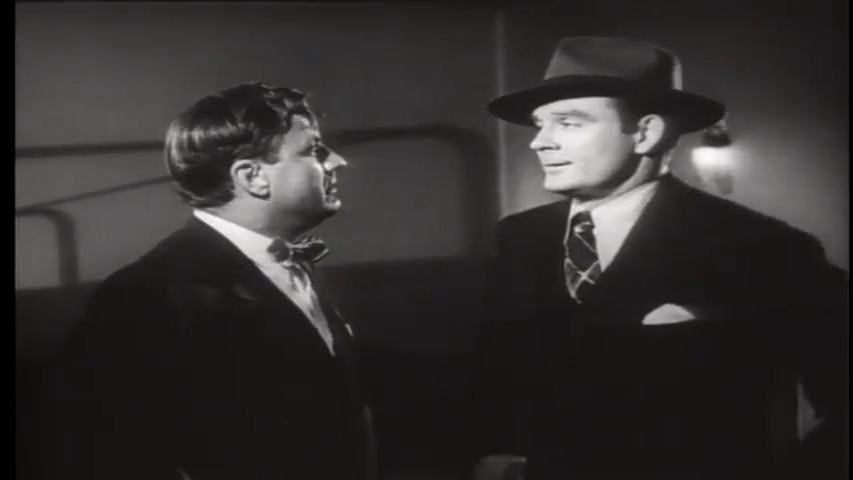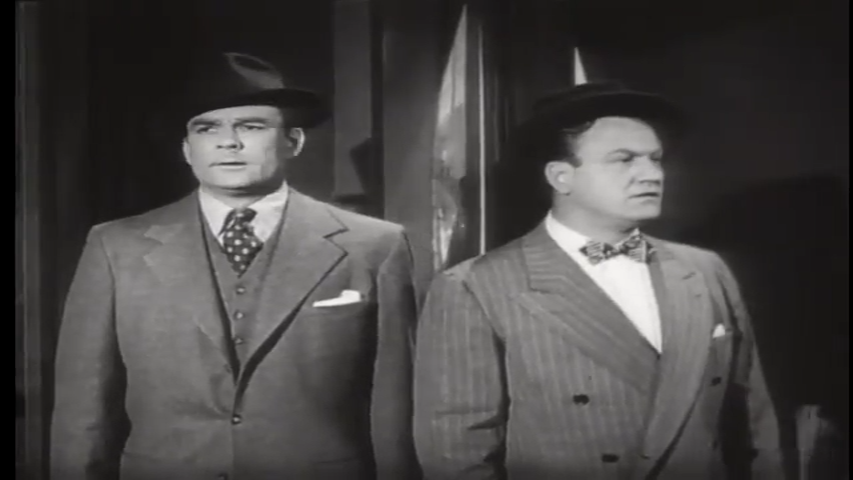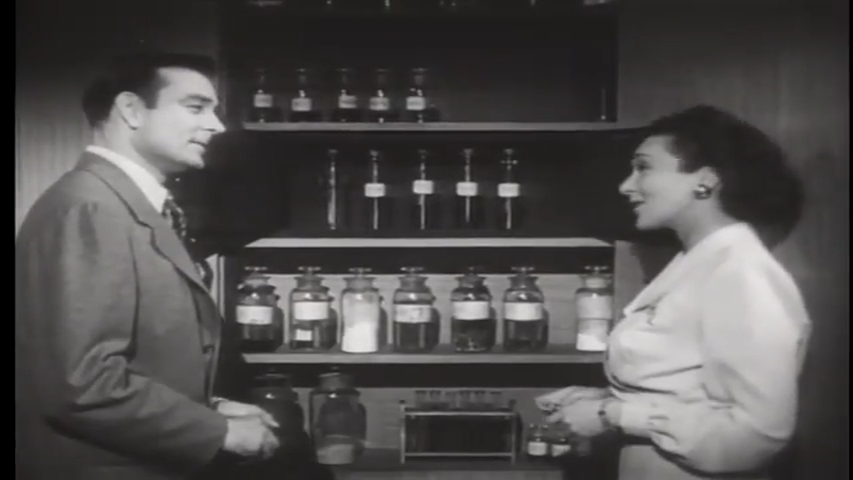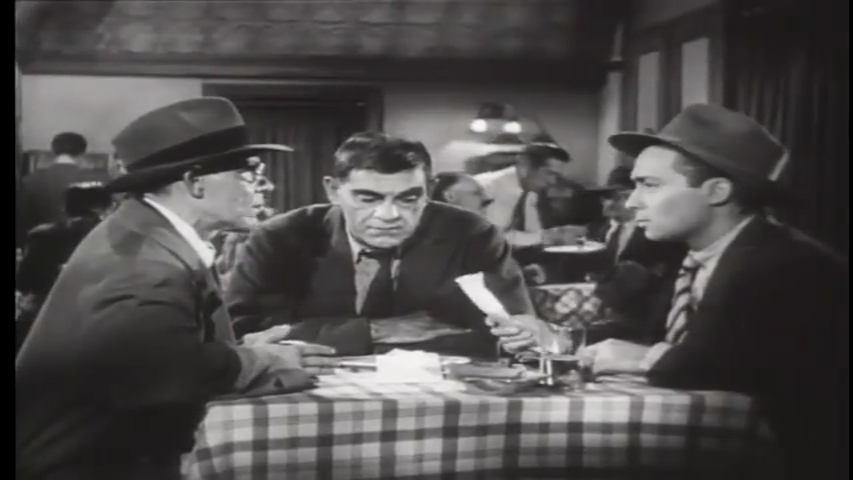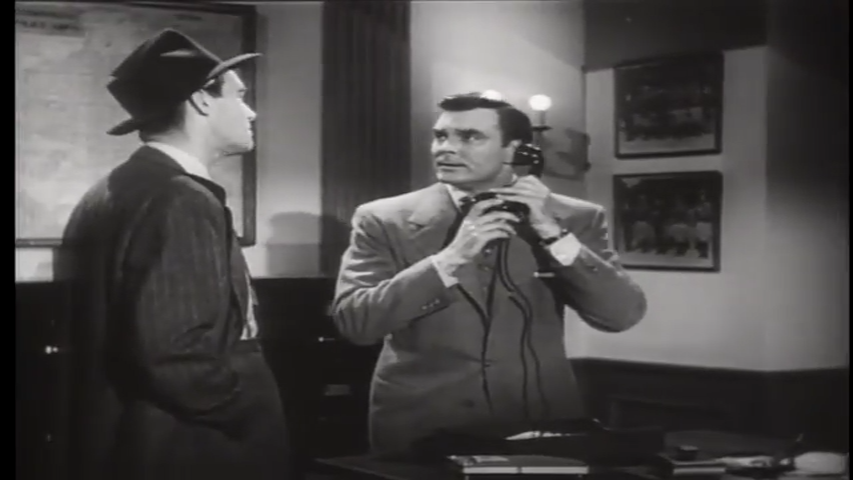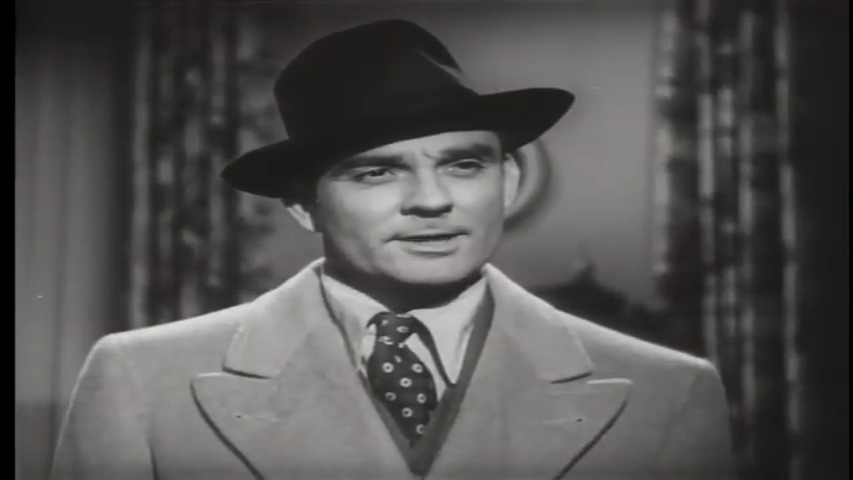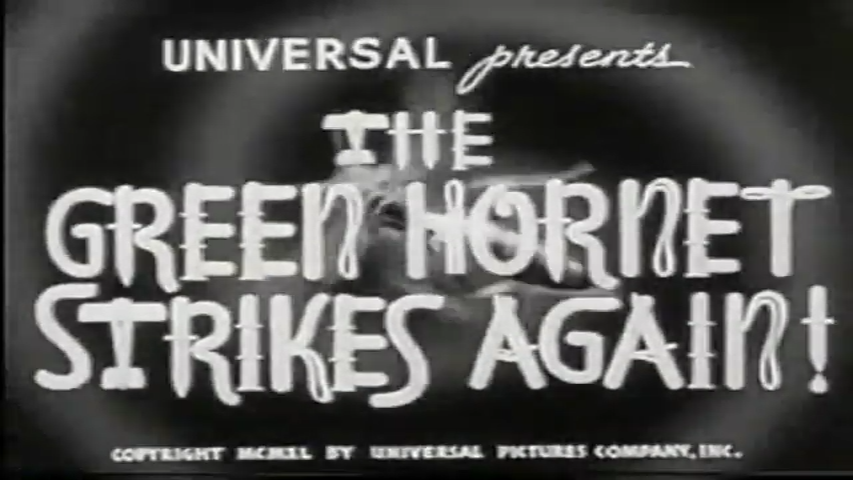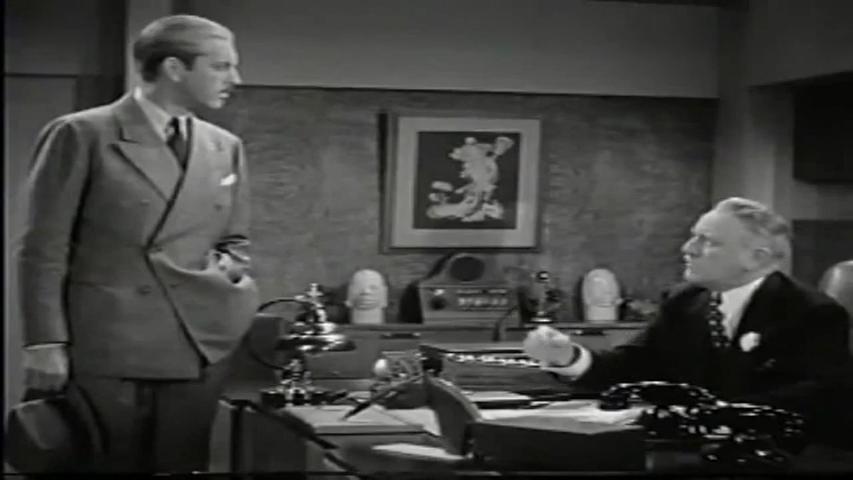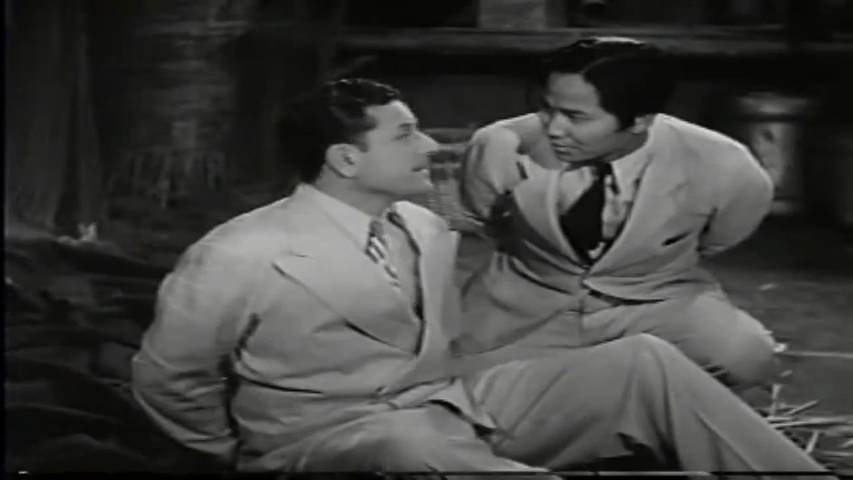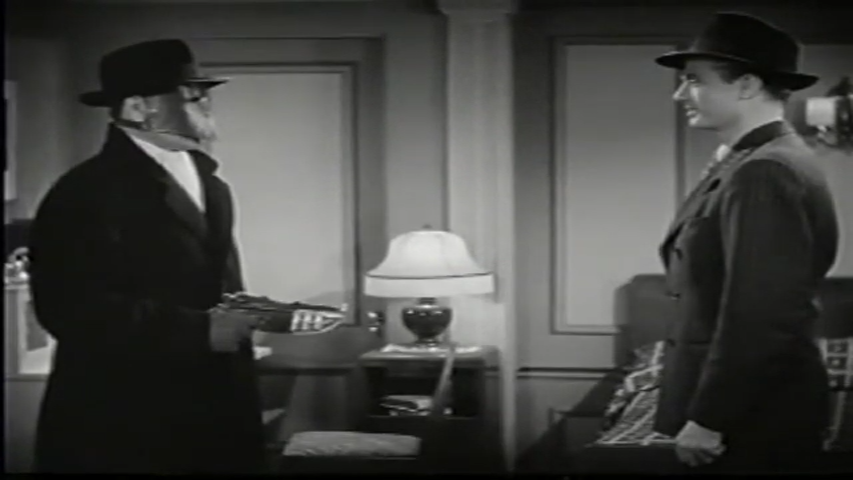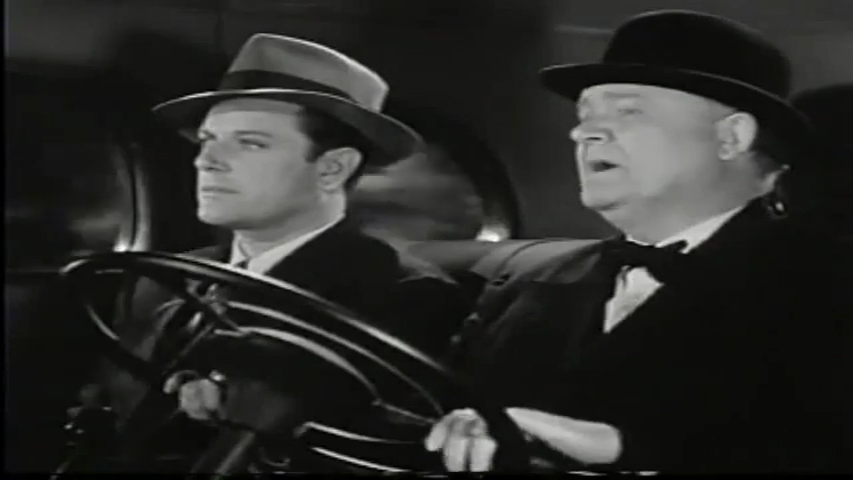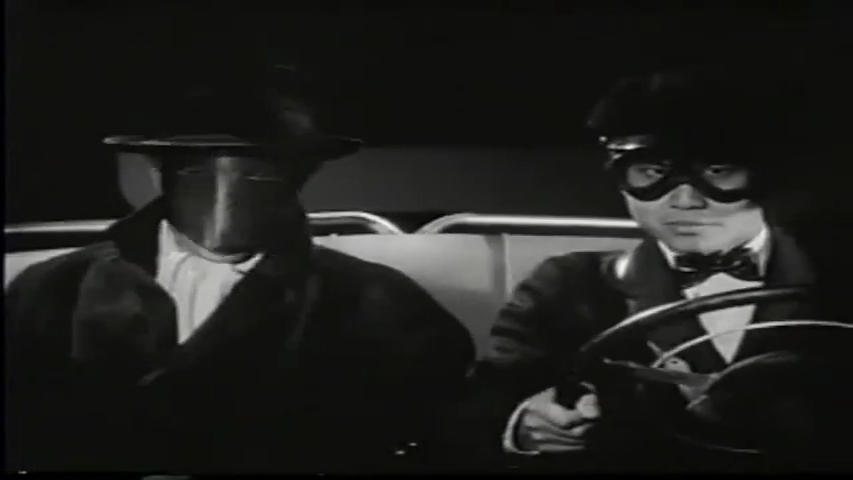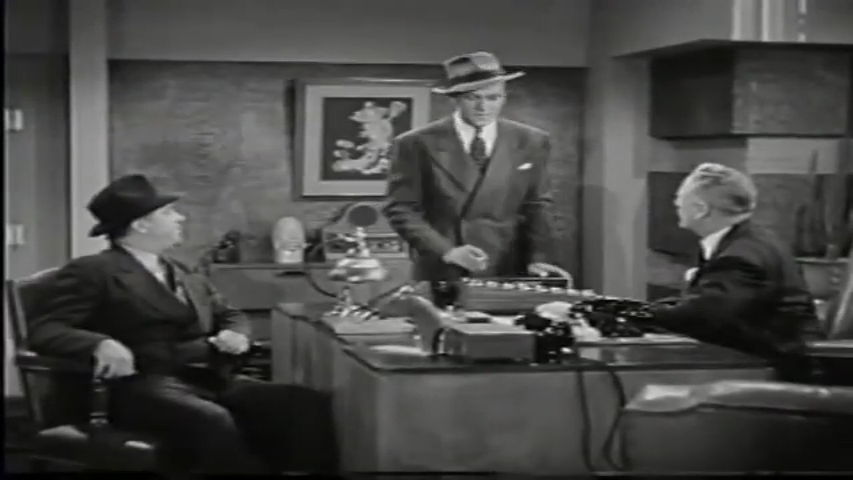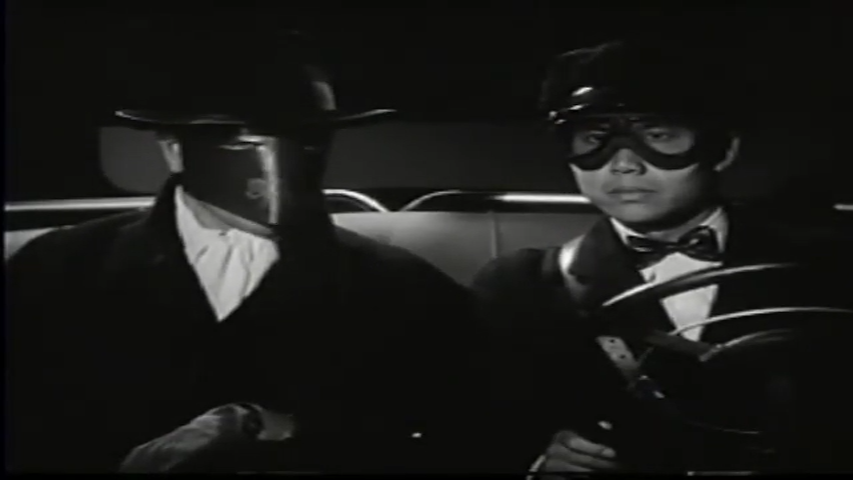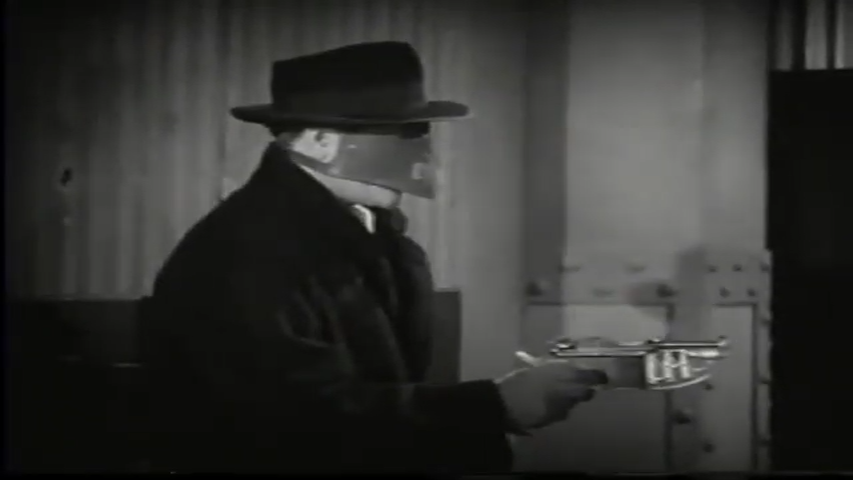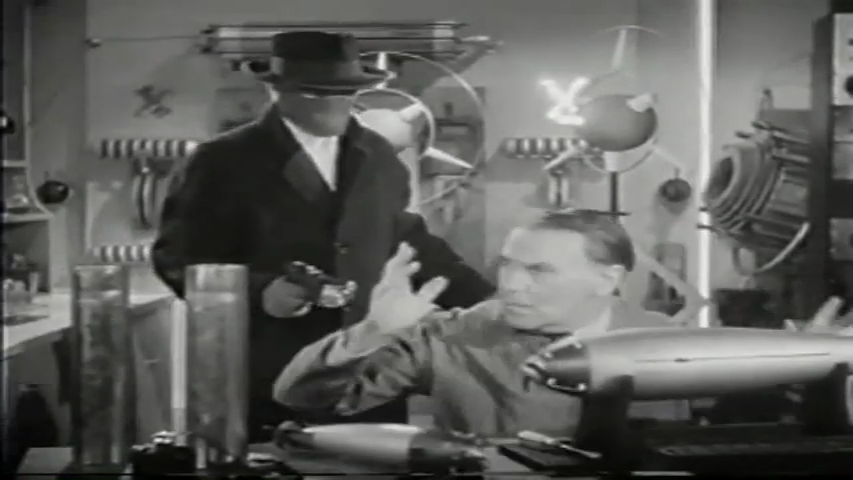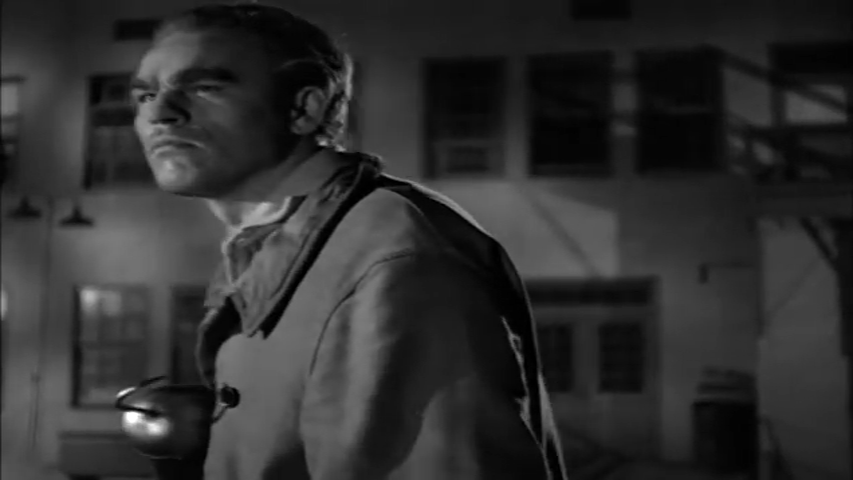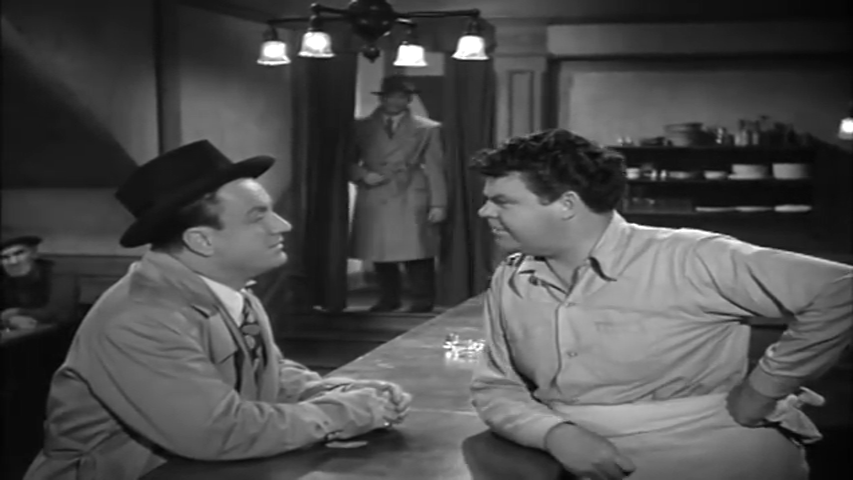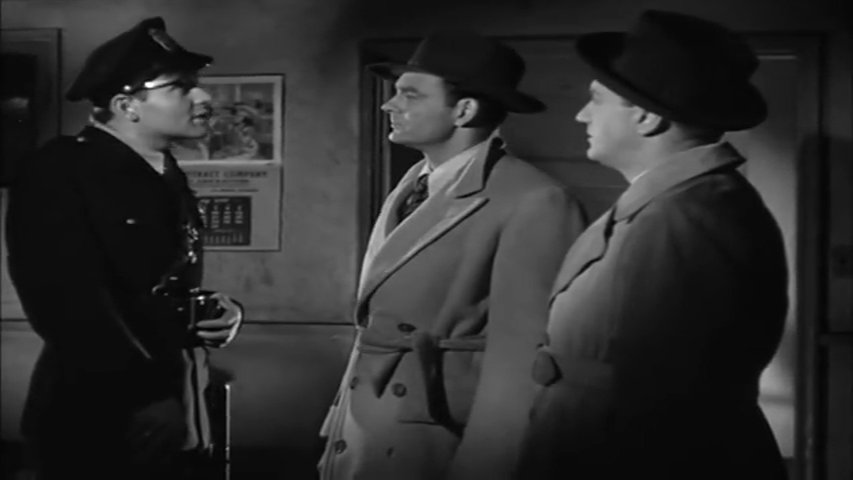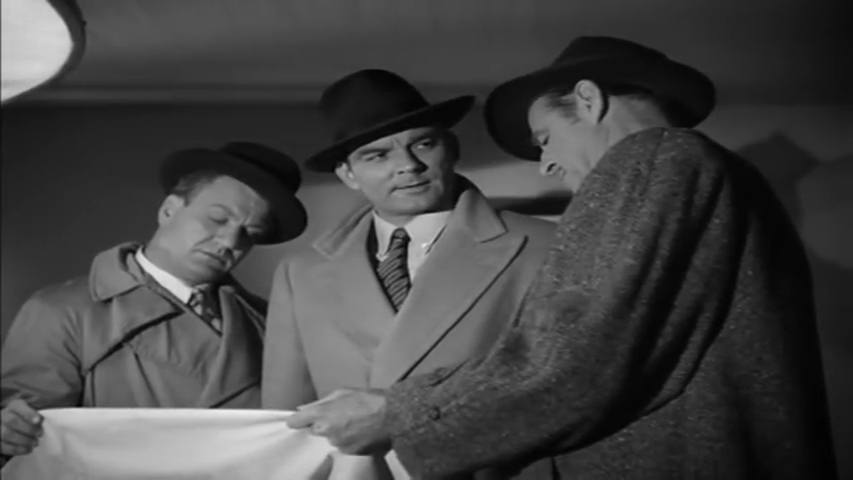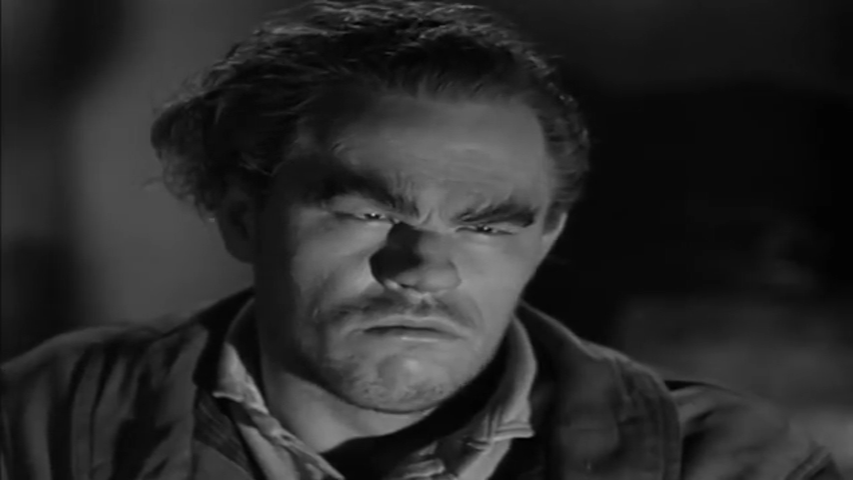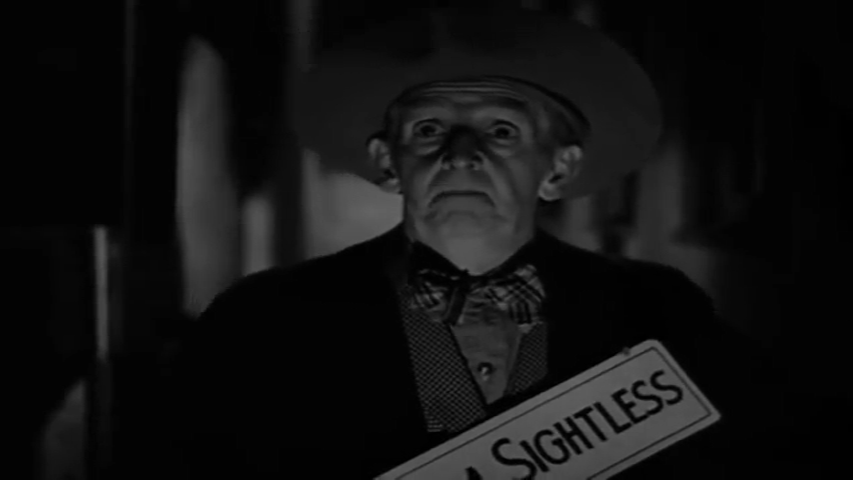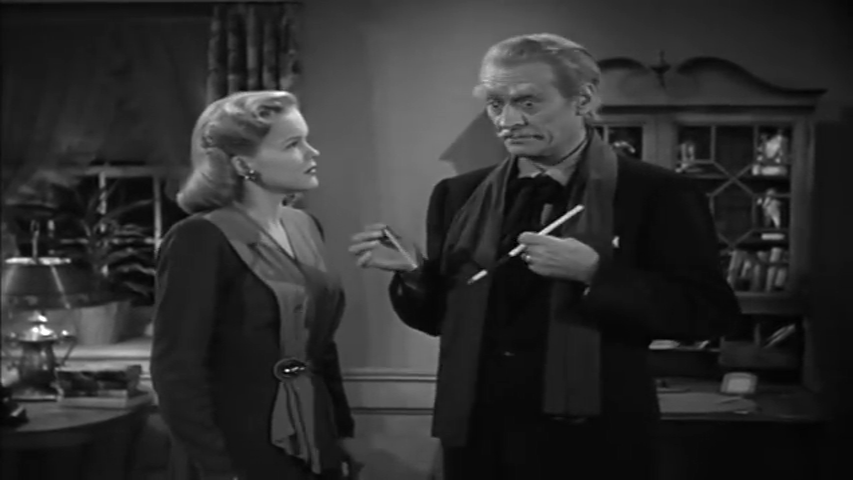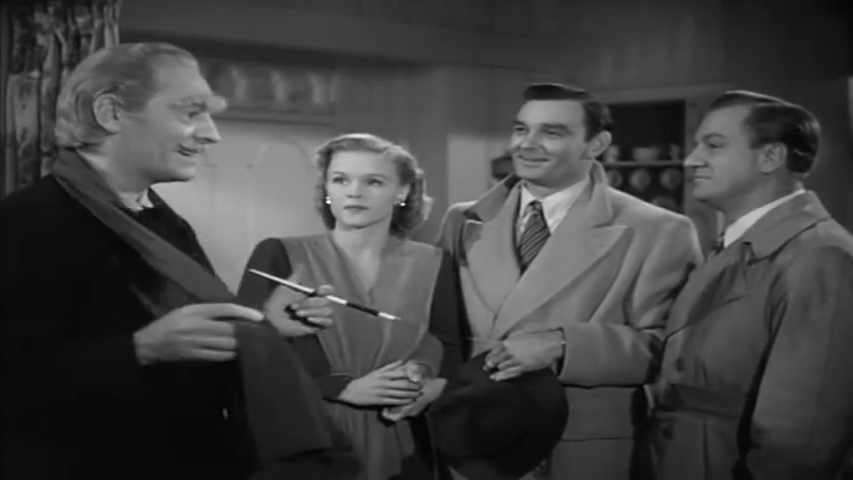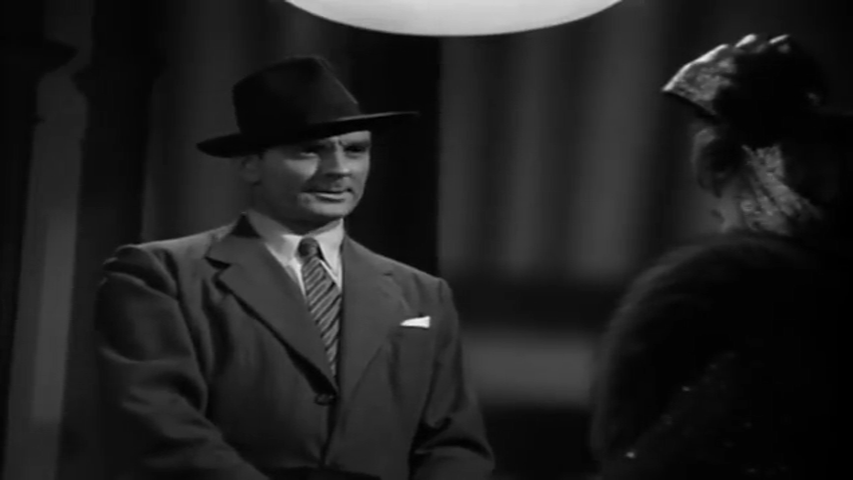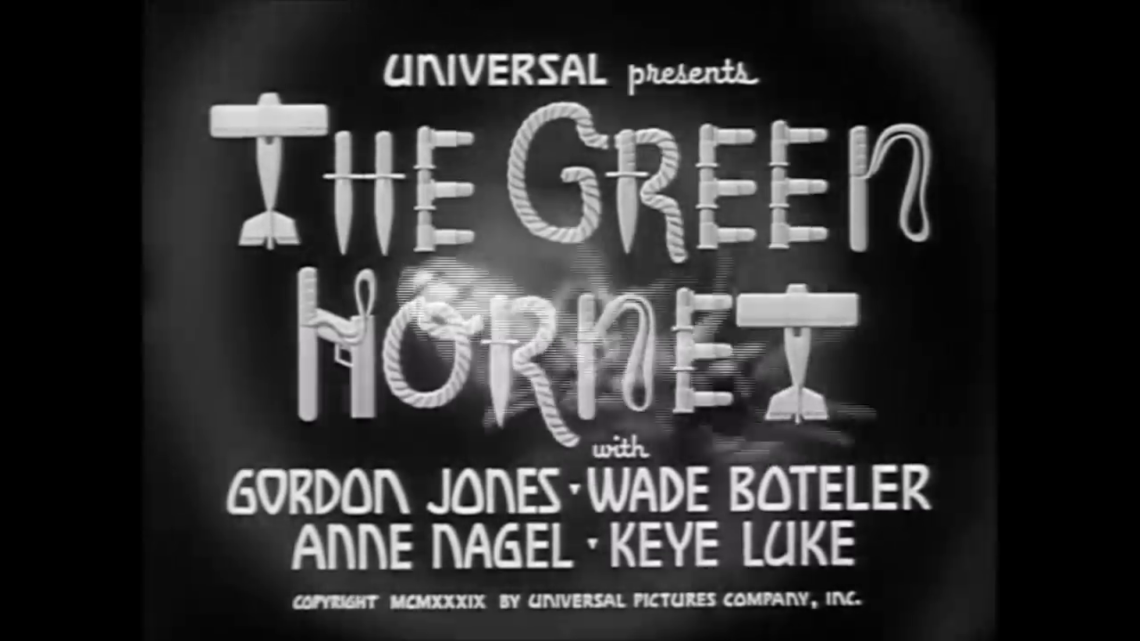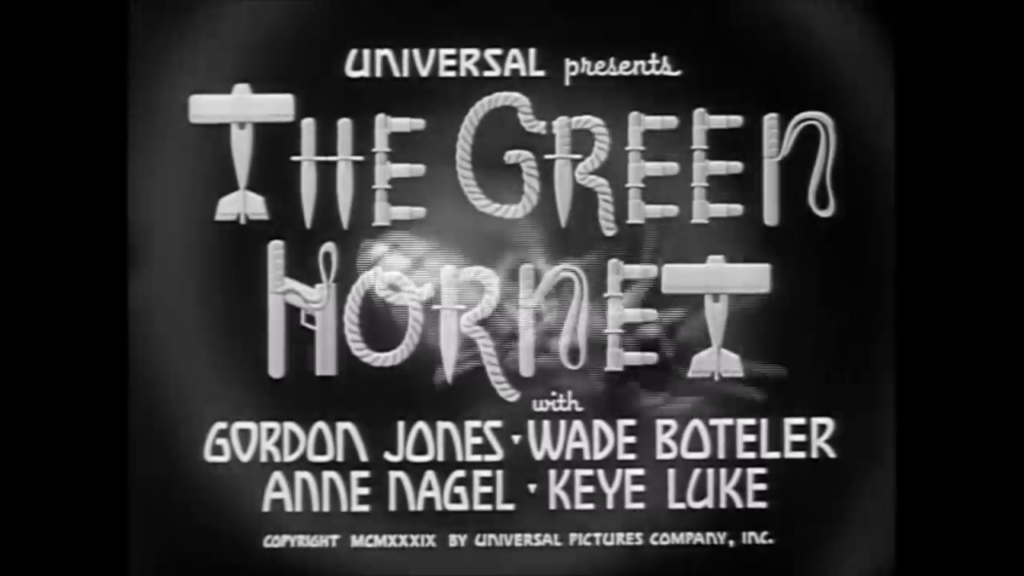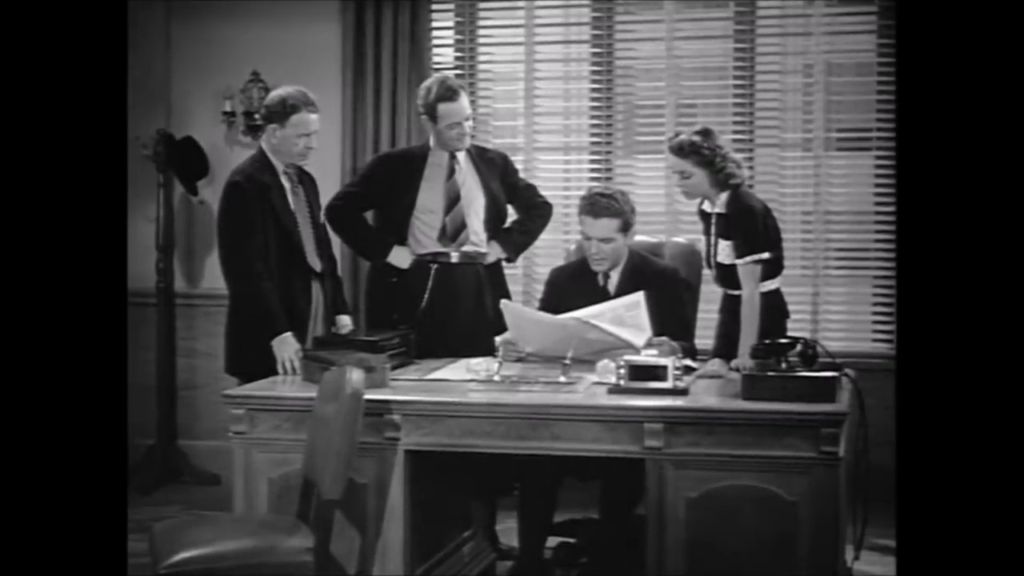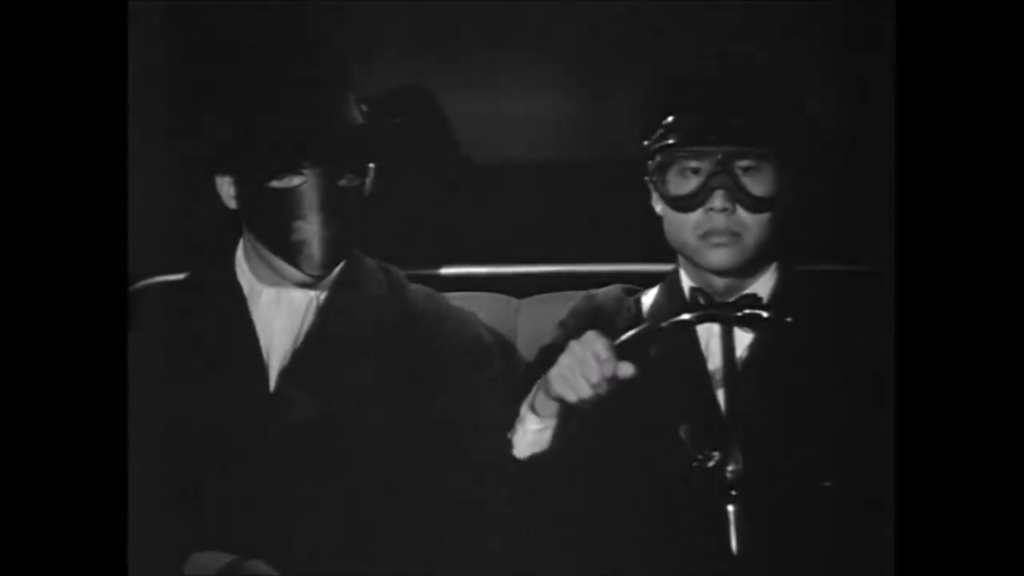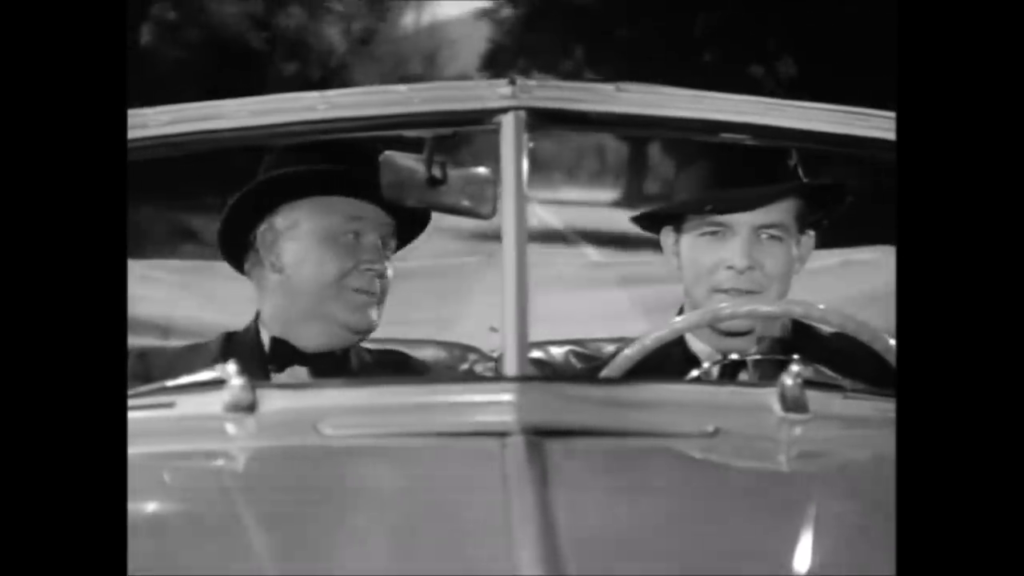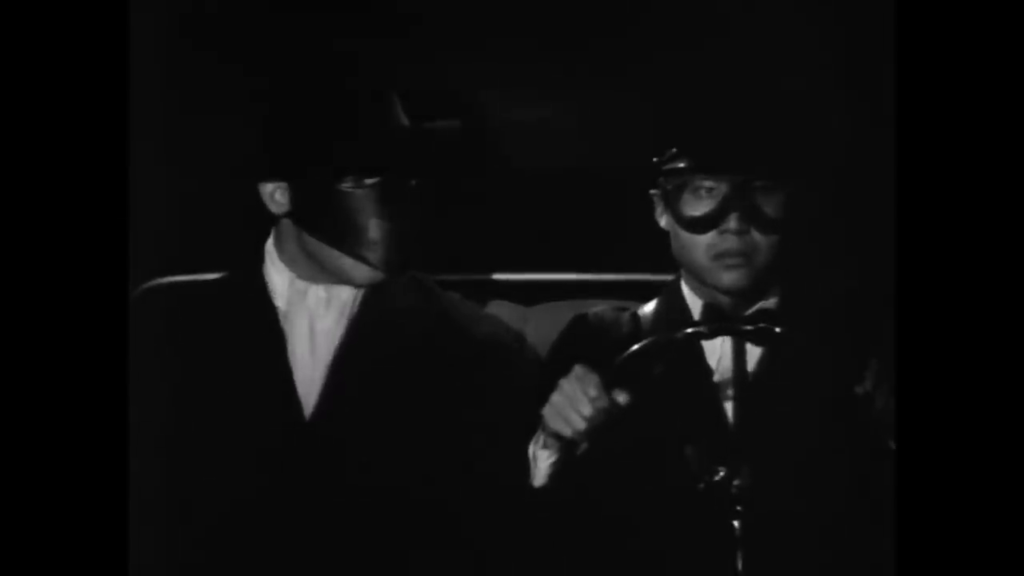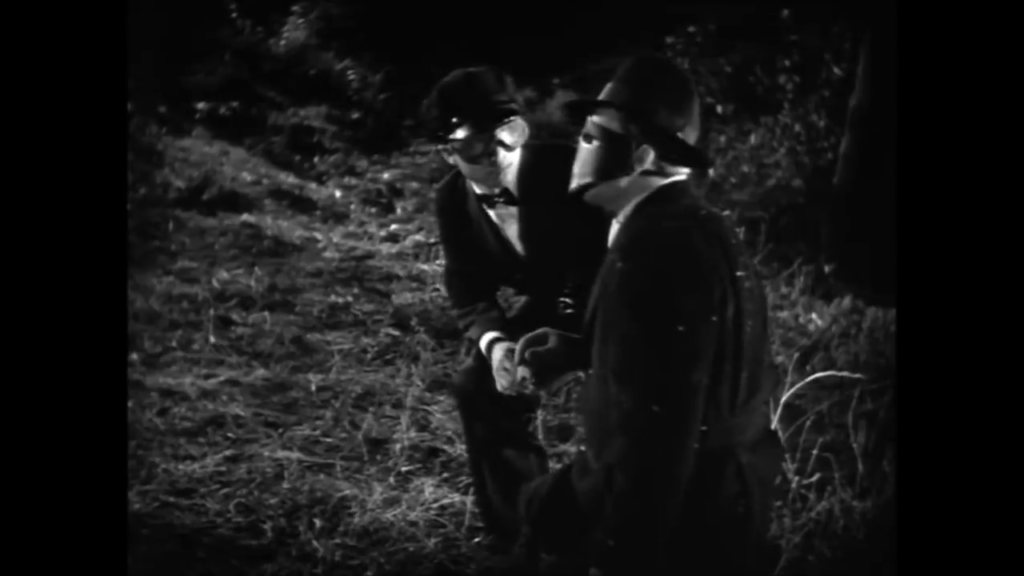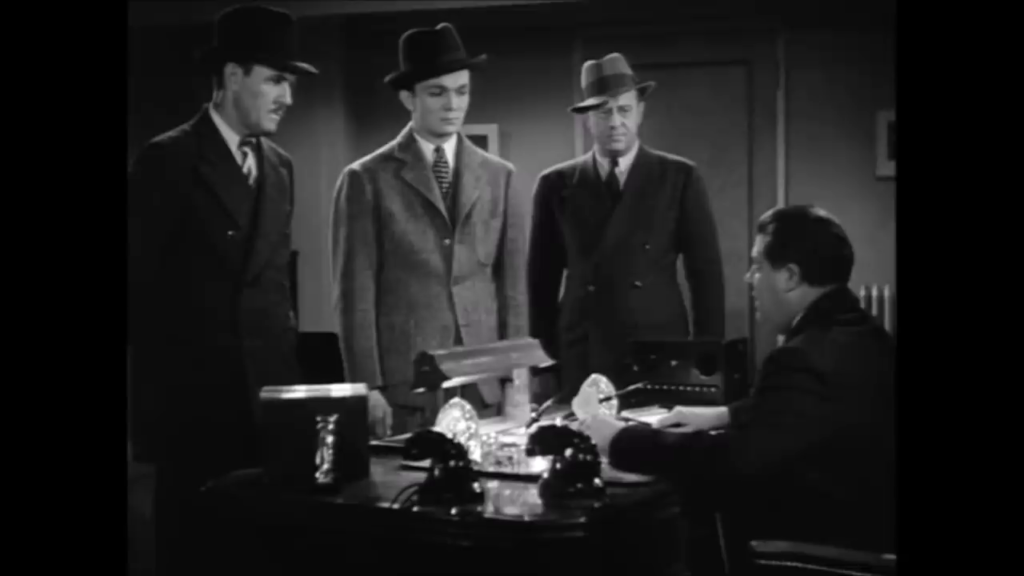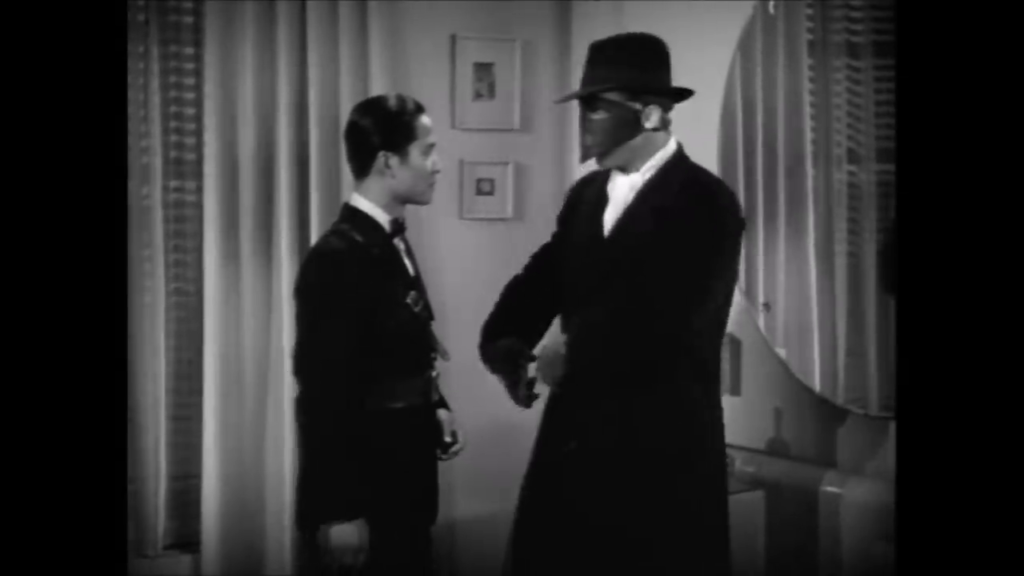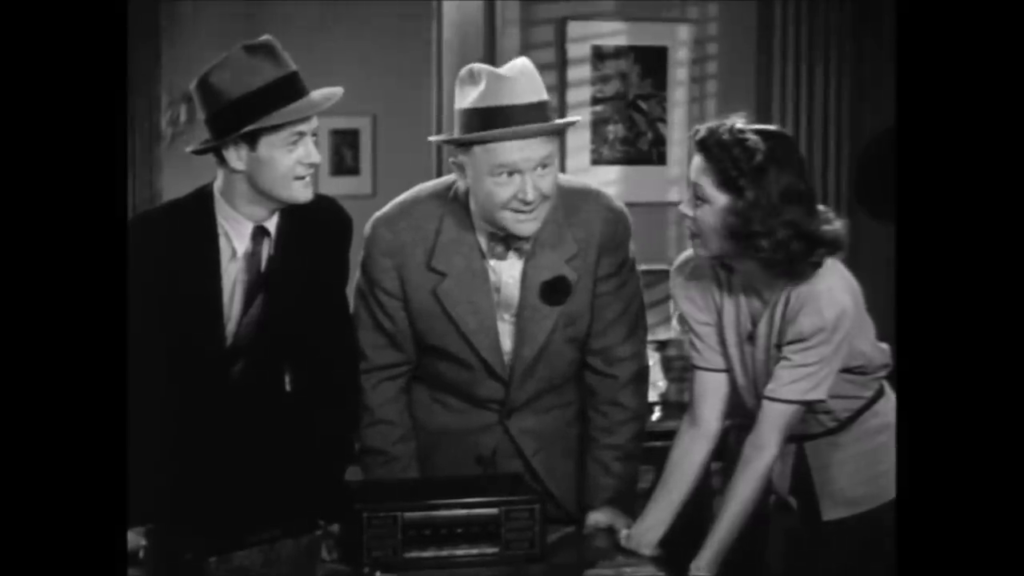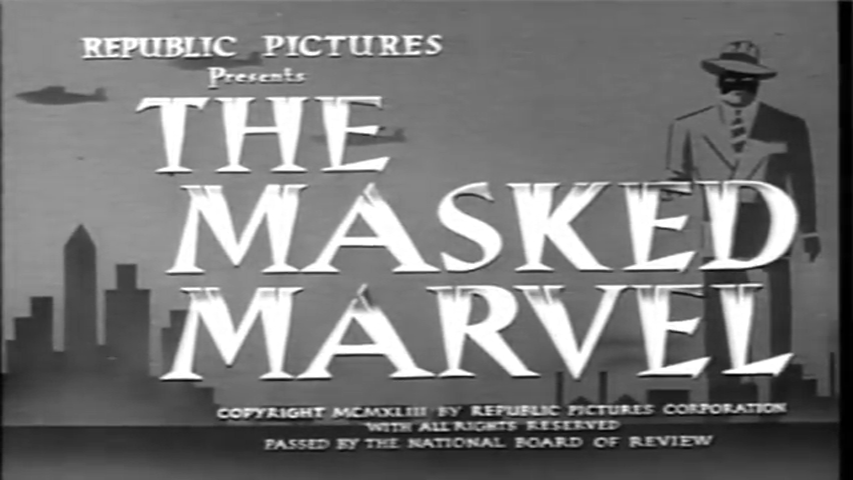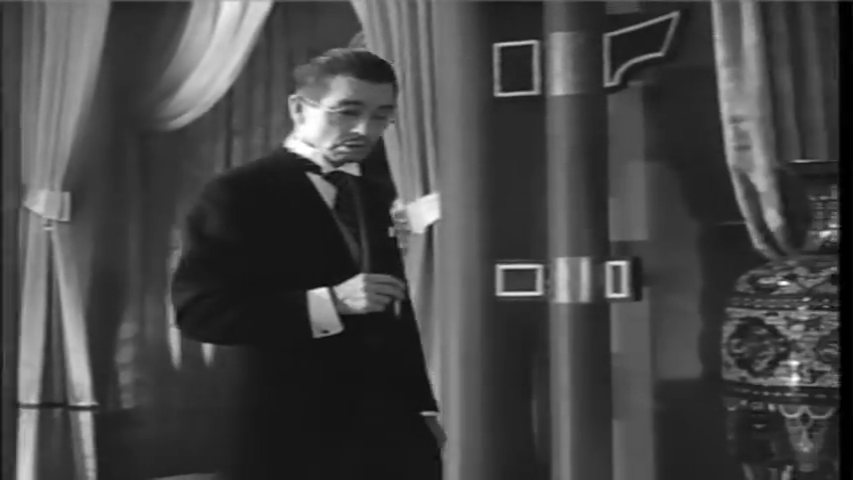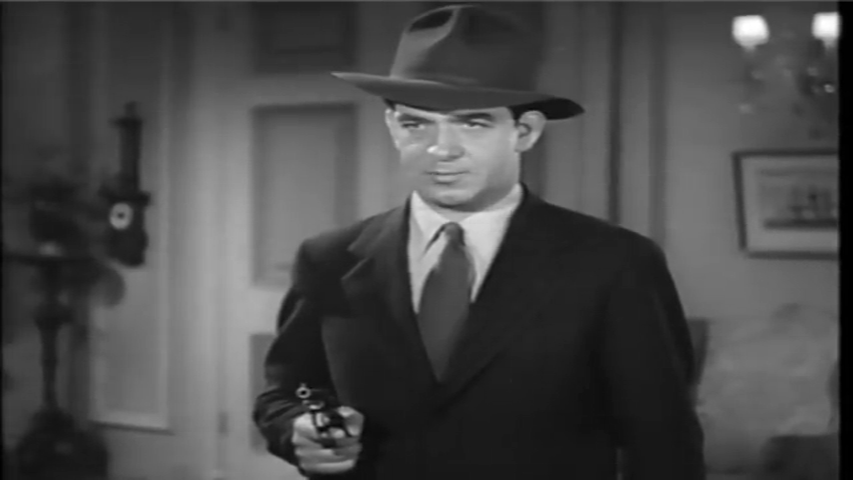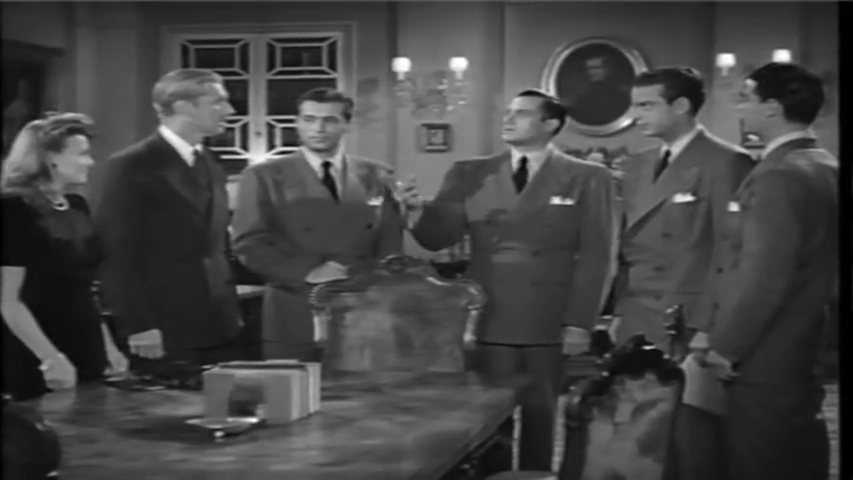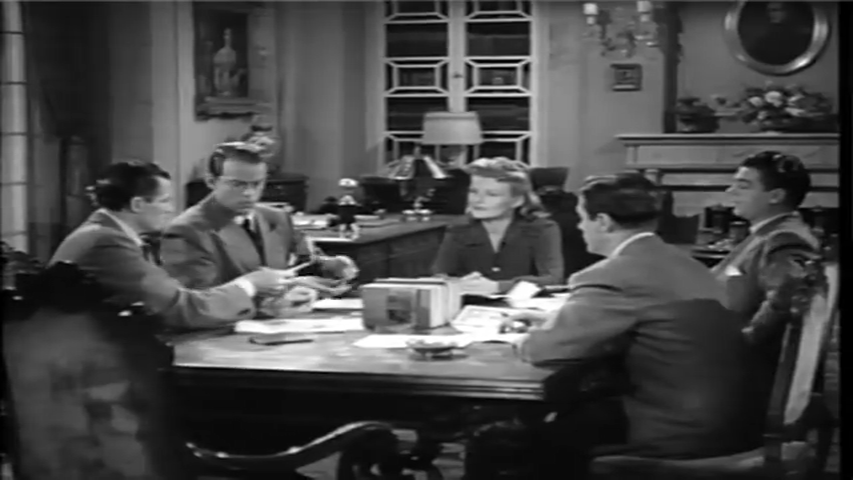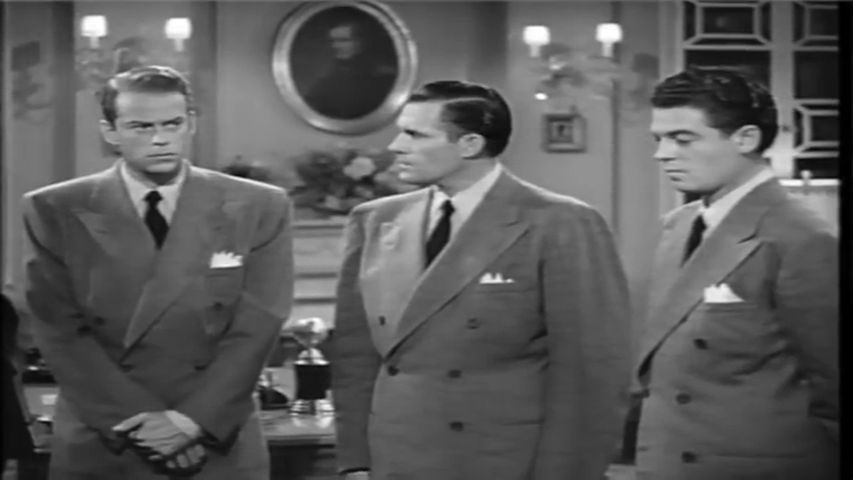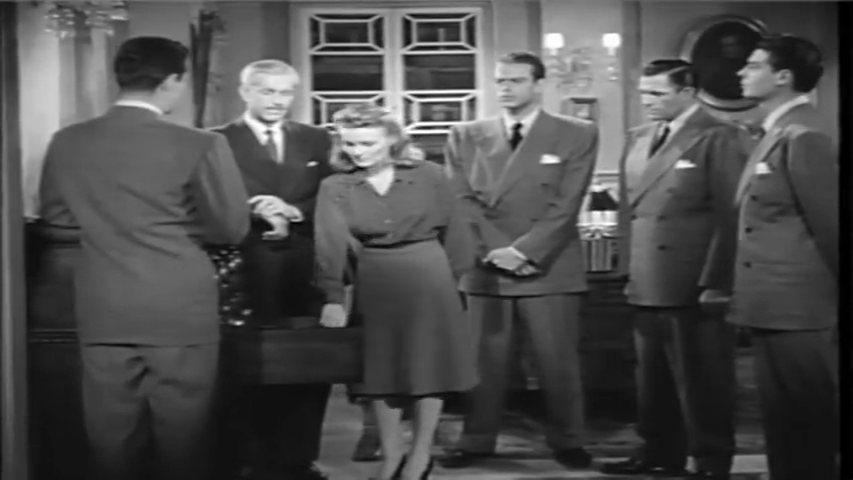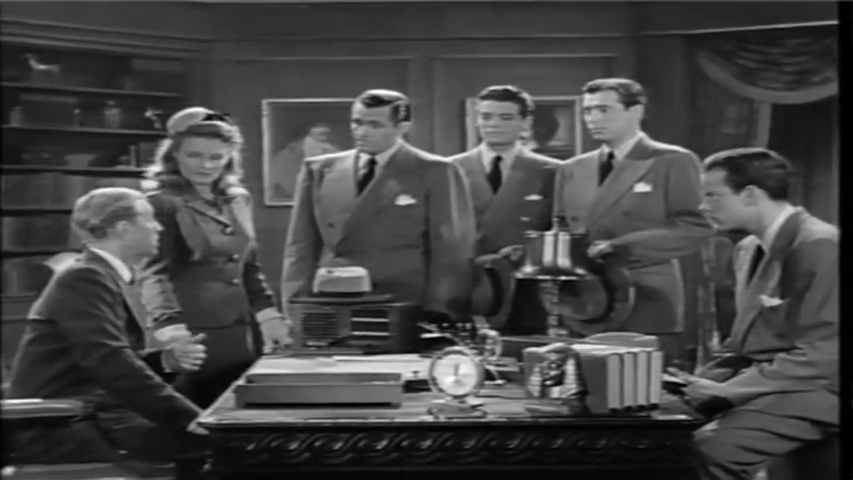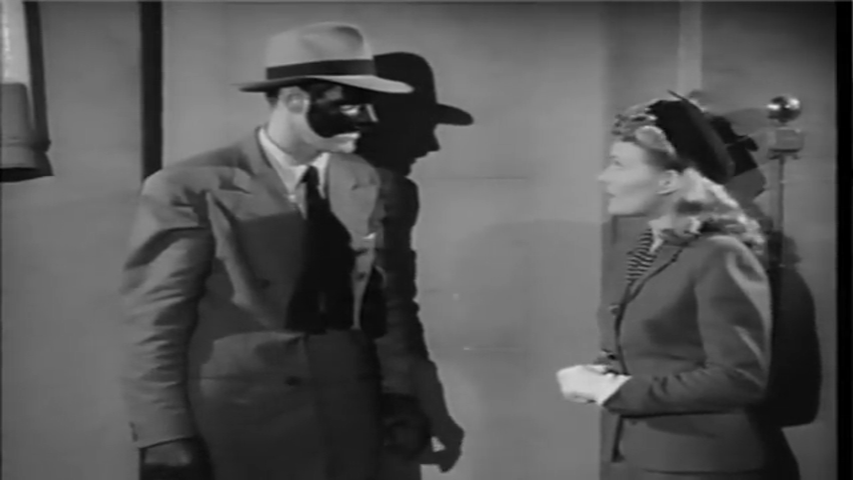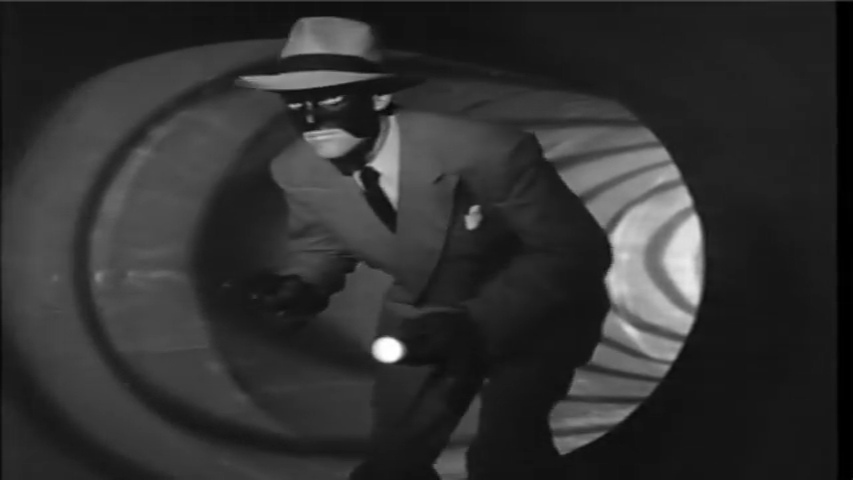-
#402 – The Monster and the Ape (1945)
The Monster and the Ape (1945)
Film review #402
Director: Howard Bretherton
SYNOPSIS: Professor Arnold at the Bainbridge Research Laboratory have completed construction on a revolutionary new robot called the “Metalogen Man” that they believe will be able to accomplish all manual labour. However, after a demonstration to Professor Ernst and three other colleagues, Ernst arranges the deaths of the other three and steals the robot for himself using a trained ape. Ken Morgan, a representative for the company who ordered the robot, teams up with Professor Arnold and his daughter Babs to stop Ernst and recover the robot, before Ernst can find more of the valuable mineral Metalogen and create an army of unstoppable robots…
THOUGHTS/ANALYSIS: The Monster and the Ape is a 1945 movie serial composed of fifteen chapters. The opening chapter sees Professor Arnold give a demonstration at the Bainbridge research Laboratory to Professor Ernst and three other colleagues of “The Metalogen Man”, a human-like robot that will be able to handle all kinds of manual labour. After the demonstration, Professor Ernst arranges the deaths of his colleagues and steals the robot for himself using a giant trained ape named Thor. Ken Morgan, the representative of the company who was going to buy the robot, arrives but finding the robot has been stolen, teams up with Professor Arnold and his daughter Babs to attempt to recover the robot. The story follows Morgan, Arnold and Babs as they try to thwart Ernst’s various schemes to unearth more of the valuable mineral Metalogen to create more robots. The story follows the usual serial format rules, with a lot of back-and-forth between the heroes and villains as the robot and it’s control unit are stolen and re-stolen throughout the fifteen chapters. There are less action scenes and very few chase scenes in vehicles which are typically a staple of the format. The cliffhangers are fairly varied and contain some elaborate traps, but you know how they’re going to end up most of the time.
The “monster” and the “ape” of the title are the robot and Thor. The robot is controlled by a control unit and looks fairly strong and menacing, with its light up eyes and bulky body. Thor is brought out of the zoo by its trainer to carry out the orders of Professor Ernst, and handles jobs such as carrying the robot, which is too heavy for any person to lift. Thor himself is played by Hollywood stuntman Ray Corrigan, who owned the ape-suit and would rent himself and the suit out to movies that required it, and he does a convincing job with it. However, we don’t see nearly enough of the two of them, and most of the action doesn’t involve them. The worst part is we never get to see the two of them fight one another, which is a hugely missed opportunity (and being shown on the posters). Thor dies by being shot in the thirteenth chapter, which is a hugely underwhelming end for the titular character. The rest of the characters follow the usual format, with the lead male doing the action and fight scenes, the sole female character who acts as an assistant or secretary, and the ‘good’ scientist who helps them. There’s also Flash, who plays a comic relief character (I’m not sure what his role in the laboratory actually is), and is played by a non-white actor, which is very rare in 1945. He is played as having a low intelligence and being a coward, which results in him being very much a racist caricature, and is quite problematic to say the least. Professor Ernst as the villain has plenty of schemes, and while he has no special powers, inventions, nor is he hidden behind a disguise like many serial villains, he still has quite an aura of menace about him.
Overall, The Monster and the Ape is a typical serial adventure with few stand outs. It has some elaborate cliffhangers and scenarios that replace the well-worn vehicle chases of other serials, but it’s titular “monsters” are vastly under-utilised, and you can’t help feel a little disappointed with the potential of a robot versus an ape, and what we actually get, which is the sparse use of both and the lack of any confrontation between them.
-
#401 – Sonic the Hedgehog (1996)
Sonic the Hedgehog (1996)
Film review #401
Director: Kazunori Ikegami
SYNOPSIS: Sonic the Hedgehog is visited with an urgent message from the President of Planet Freedom. When he goes to visit him, Sonic finds none other than his arch nemesis Dr. Robotnik, who actually wants Sonic’s help in destroying Metal Robotnik, a robot who has taken over the city of Robotropolis, where the generator for the city is about to go critical and endanger the whole planet unless Sonic can go and defeat Metal Robotnik and shut the generator down. Meanwhile, Robotnik has his own schemes at work, including one for a certain “Hyper Metal Sonic”…
THOUGHTS/ANALYSIS: Sonic the Hedgehog is a 1997 animated film made from a two-part Original Video Animation (commonly known as OVA) released in Japan. The story opens up with Sonic and Tails relaxing on a beach when they are visited by an owl who is only referred to as “the old man.” He tells them that the President of Planet Freedom wishes to see them urgently. When they arrive, Sonic and Tails find their nemesis Dr. Robotnik there, who actually wants their help. Robotnik has been forced out of his home of Robotropolis by Metal Robotnik, and the generator in the city will overload and destroy the planet soon if it is not shut down. Sonic and Tails agree to do it, and travel to Robotropolis. The story throws you into the middle of this world with little explanation of what is going on (with the brief exception of the world being divided between an upper world of floating islands, and a lower world of darkness where Robotropolis is). That’s not necessary a problem though, as a blue hedgehog that runs really fast doesn’t need too much of a backstory or exposition to engage the viewer. The characters are recognisable and act more or less how you would expect them too, so you get what you would want in that respect in a movie about the video game character.
Sonic and Tails arrive in the lower world of darkness and encounter Metal Robotnik, and battle takes place in the ruins of what seems to be New York City, suggesting planet Freedom is actually Earth in the distant future. The action is fast-paced and delivers what you’d expect, with lots of running and jumping all over the place. Sonic and Tails are saved by Knuckles, who again is more or less the character you would expect him to be. The second part of the film sees Sonic facing off against “Hyper Metal Sonic,” a robot version of Sonic created by Robotnik. There’s not too much to say about this part of the movie, as it is more or less a straight-up fight between Sonic and Metal Sonic, with the other characters sometimes interjecting. Again, this isn’t so bad in terms of the characters and world themselves don’t need to have a comprehensive story mapped out for you. I think it more or less delivers what it needs to, but since it clocks in at under an hour, it feels like there’s a lot more that could have been done.
As mentioned, this movie was composed of a two-part Japanese animation, and re-edited into a single movie for an English release. The dubbing industry at the time was not particularly great, but the English voices are all pretty terrible. Sonic sounds very nasally, but has a bit of the attitude you would expect him to. Tails sounds awful and always sounds like he has a cold. Robotnik’s voice is fairly decent, and sounds fairly similar to the voice he has in the video games that preceded this movie. The animation as well often feels cheap and fragmentary with a lack of frames making the animation feel rough, which destroys any sense of speed and fluidity that the movie really needs to show off Sonic’s speed. A lot of the expressions of the characters and their style or reactions are those that are typical of Japanese animation, and don’t really translate too well. This is again an issue around the early dubbing industry still finding its feet with how to approach the Japanese animation style.
Overall, Sonic the Hedgehog is a brief foray into the world of the titular character. It doesn’t establish any deep story elements or incorporate any of the stories from the games, but relies on the recognisable characters doing what you would expect them to, and leaves the detail of the world to the imagination. The quality of animation and voices really hampers the feel of the film at points, and the style of animation is awkwardly interpreted at times, but there’s some decent action scenes, and portrays the characters in a way that one would more or less expect.
-
#400 – Sonic the Hedgehog (2020)
Sonic the Hedgehog (2020)
Film review #400
Director: Jeff Fowler
SYNOPSIS: Sonic, a hedgehog who was borne with super speed, is chased from his homeworld, and transports to Earth where he must hide by himself so the same thing does not happen again, and someone else attempts to capture him for his powers. Spending ten years hiding on the outskirts of the rural town of Green Hills, he has grown attached to some of the locals without them knowing of his presence. Police officer Tom Wachowski and his wife Maddie are two people has grown particularly fond of. When an overuse of Sonic’s powers triggers a large scale power outage, the government sends in their specialist Dr. Robotnik to investigate the cause, and finds that Sonic’s speed could be a source of infinite power for his robots, if he can just gets his hands on him…
THOUGHTS/ANALYSIS: Sonic the Hedgehog is a 2020 film based on the popular video game character of the same name. The story opens with some backstory, as Sonic tells us about his home on another planet, which he had to flee because there were those who wanted to capture him for his powers to run incredibly fast. He flees to Earth under the instruction to trust no one. Ten years later, he is living in a hideout in the woods near a rural town called Green Hills. Here, he keeps an eye on the locals, but never shows himself to them. When his powers inadvertently caused a huge power outage and the government tasks scientist Dr. Robotnik with investigating, Sonic has the local sheriff Tom Wachowski help him get to San Francisco to gets his rings back which can transport him to a new world where he will be safe. The film’s story is very straightforward, with it being a typical ‘fish out of water’ plot and Sonic getting used to being around humans. I suppose there’s a bit of a twist with Sonic not trying to find his way home, but to escape his new home, but it doesn’t affect the feeling that the plot is something you’ve seen plenty of times before. Nevertheless, the themes are consistent, and tie up with Tom’s plot of wanting to move away from his home to San Francisco to do some ‘real’ police work there. The focus really isn’t on the story as this primarily aimed at children, and the fast one-liners and light-hearted back-and-forths between characters keep things going at a smooth pace so as to keep attention. In this respect, the film succeeds rather well, even if it fails to create anything innovative or deep in it’s plot. That said, there’s a lot of references to different aspects of the franchise’s history that more devoted fans will appreciate, so the film tries to saddle all audiences along for the ride.
The story primarily serves as an origin story for Sonic, so it doesn’t really get into the content that the video game franchise has made over the past thirty years. Characters like Sonic don’t even need an origin story: he is a blue hedgehog who runs really fast and fights robots created by a scientist named Robotnik. Sonic is typically characterised as having an “attitude” and cool personality (in the nineties anyway), and a carefree approach to life. The Sonic in this film doesn’t really fit that character, as he is a little more naive and troubled, but again it is an origin story featuring a younger Sonic than we’re used to, so it’s not a real issue (in the games he is typically listed as being sixteen years old, here is is probably around ten or eleven, but that’s getting a bit too technical). Tom Wachowski is a fairly standard character in these types of films, but is nevertheless likeable, and has his own plot that gives him a purpose for being on screen. He played almost the exact same character in the film Hop, the only real difference being it was the Easter Bunny he was dealing with instead of a blue hedgehog, so at least he has some experience in this kind of role. However, the stand-out performance has to go to Jim Carrey for his portrayal of genius (and mad) scientist Dr. Robotnik. He is definitely not the first person you would think of in casting Robotnik, but he definitely makes it work: he is mostly portraying him as he did for most of his roles in the nineties, but his energy really brings life into the film, and his expressive acting is hugely entertaining, even if it is just Jim Carrey being Jim Carrey. Despite this, he also manages to give the role a bit of a menacing feel, and portrays the character as a genius who is undone by his own hubris (as described by Carrey himself) gives a surprising amount of depth to his role. It would have been nice to have some more direct Sonic/Robotnik interaction though.
The first trailer for this film was met with near universal criticism, mostly because of Sonic’s design, which made him look more human with larger arms and legs and smaller eyes, but the combination of Sonic, who very much a mickey-mouse character, combined with human proportions was a horrific combination, and the backlash was so great that his CG model was completely re-designed, forcing the film’s delay. The re-done Sonic managed to achieve the impossible and was welcomed by almost everyone: such a 180-turn-about is almost unheard of (particularly in the Sonic fandom). While Sonic still looks like a CG animation and never looks truly immersed in the real-world setting, his face and body are expressive and fluid, while still being colourful and cartoony enough to retain that consistency with the character people know. I suppose a minor issue I have is that Sonic’s arms are not supposed to be blue, but that really is a personal and minor grievance.
Overall, Sonic the Hedgehog feels like a 90′s film for a 90′s character. While the iconic characters are given a strong presence on film, the story is devoid of any real originality, and moves scene-to-scene rather awkwardly. Despite this, the central themes are consistent and resonate with most of the cast, and the story is fast paced and fun so as to not get boring and keep the appeal of it’s younger target audience. The characters are likeable and have definite presence, aided by fun and quick dialogue, but don’t particularly develop in a unique manner. Given the track record of video game movies being typically disasters, Sonic the Hedgehog avoids that fate for the most part, and sets up some interesting story elements that could form the basis of sequels to develop the characters and worlds in a promising direction.
-
#399 – Dick Tracy (1990)
Dick Tracy (1990)
Film review #399
Director: Warren Beatty
SYNOPSIS: Detective Dick Tracy is busy attempting to clean up the city of the criminals that are terrorising it. He rescues a homeless kid from a criminal, and ends up having to look after him along with his girlfriend Tess Trueheart. Meanwhile, Big Boy Caprice has united all of the city’s mobsters under his rule, and the only way Tracy can get him locked up is to convince Breathless Mahoney to testify against him, who seems to have her own agenda altogether…
THOUGHTS/ANALYSIS: Dick Tracy is a 1990 film based on the comic strips of the same name created by Chester Gould. The film starts out with Dick Tracy on the trail of criminal Lips, who turns up dead. Tracy suspects the work of Big Boy Caprice, but his evidence hinges on the testimony of Breathless Mahoney, who witnessed Lips being buried in cement (Tracy found one of her earrings at the scene of the crime). Tracy also manages to apprehend a nameless kid who is pick-pocketing and decides to have the kid stay with him. Meanwhile Big Boy Caprice has managed to unite all of the city’s criminals under his rule, and Tracy has to find a way to put a stop to them. The story is…well, there’s lots of it. On one hand, it adds in a lot of the characters and ideas from the comics, but on the other, it adds too many without exploring them in depth; it just throws the characters in with a bunch of others with no time to really develop them. The opening of the film basically throws the viewer into the deep end with Tracy trying to apprehend these criminals that he clearly has a history with, but we aren’t given much of an insight into it and why Tracy is so intent on pursuing these criminals at all costs. In one sense, in keeping with the comic strip origins, not everything needs to be explained, nor for a reader to read every single comic strip to understand what’s going on. In the case of a self-contained film, however, the motivations of the characters really need to be at least signposted through recaps, flashbacks or some other narrative device. The film is simple enough to follow, and doesn’t have too many interruptions to its flow, but there’s such an interesting setting and cast of characters that aren’t delved into that it is a little disappointing. At least the film sticks to the comic’s origins in the mobster-filled, crime-noir genre rather than going into the sci-fi stories involving aliens living on the Moon that the comic went into in the sixties. The only sci-fi element that shows up is the communicator watch that Tracy wears, and that doesn’t really stand out too much from the setting. A small problem I have with the ending is that Caprice ends up getting killed, which I think would have been better if instead he was arrested and sent to jail, as that’s what Tracy’s goal was throughout the whole film.
The film’s biggest strength is by far its cinematography and style. I don’t think there is anything else like it (especially at the time it was released). The backgrounds and cityscape shots are large scale matte paintings done in a traditional comic perspective that are brought to life with amazing detail and colour. The colour on the whole is incredibly striking, with high contrast props, sets and costumes making individual elements stand out in shots. For example, Tracy’s distinctive cream coloured hat and coat are saturated and give him a commanding presence in the dark shots of the city at night. Every character too wears a similar high saturated colour, making them recognisable and visually appealing. In doing so, the film overcomes the paradox of having a crime-noir in full colour by replicating the high contrast of ‘noir’ through highly saturated colour. Not only this, but it also manages to pay homage to the typically flat colours associated with comic strips. All of this is a remarkable achievement that also doesn’t feel very dated. The other striking element of the film’s style is it’s use of prostheses and make-up to give the villain’s comic book proportions. For example, Pruneface has these huge wrinkles covering his face that make him look like a prune, Flattop has a…flat top of his head. It’s cartoony, but they all still have a menacing aura about them thanks to the exceptional work of the prosthesis. If you’re going to remember this film for anything, then it is its style and vision which will stay with you.
The characters themselves definitely have plenty of personality, though as mentioned there could do with exploring in greater depth some of these interesting-looking people. Tracy, played by Warren Beatty, who also directed the film, feels like he’s channelling Harrison Ford (particularly Indiana Jones) in his performance. Sometimes he is straight-laced, sometimes he is quick-thinking and action-oriented. Al Pacino as Big Boy Caprice has a commanding presence and the prostheses that fills out his body compliments that nicely. Breathless Mahoney is played by Madonna, who turns in an alluring performance as well as performing some original cabaret songs that hit the mark. The mixture of drama and comedy again is executed well, with a good amount of visual gags that are easy to miss given Tracy’s often straight-faced response. His interactions with the character Mumbles (who mumbles everything he says) is in particular a chance for the film to strike a humourous note.
Overall, Dick Tracy offers a visual treat that manages to pull off the aesthetics of crime-noir and comic book drama with a striking use of colour and convincing make-up that situates every element of the film perfectly in the world it creates. The result is a memorable visual experience coupled with some dramatic and over-the-top performances. The story suffers from having too much going on and not enough depth to the most important elements, but on the whole it is still enjoyable enough to sit through.
-
#398 – Flying Disc Man from Mars (1950)
Flying Disc Man from Mars (1950)
Film review #398
Director: Fred C. Brannon
SYNOPSIS: Scientist Dr. Bryant goes to investigate a strange aircraft that has has crashed to Earth. There, he finds that a Man named Mato who has come from Mars with the aim of placing the Earth under Mars’ absolute dictatorship. He blackmails Dr. Bryant in this scheme, knowing about his secret past as a Nazi scientist during the war, into using his scientific knowledge and resources to construct weapons to achieve this task. Meanwhile, Kent Fowler, who owns a security company that uses planes, and who was also hired by Bryant to act as security around his factory before the ship crashed, must find a way to the criminal’s plans to steal the components necessary to build atomic weaponry.
THOUGHTS/ANALYSIS: Flying Disc Man from Mars is a 1950 movie serial composed of twelve chapters. The first chapter opens up strongly (as they all do in order to get viewers into the theatre and subsequently back for the remaining chapters), as Dr. Bryant, a scientist and owner of a manufacturing company, hires Kent Fowler, the owner of security company that patrols in a fleet of aeroplanes, to patrol the grounds of his factory, as there have been sightings of strange ships in the sky recently. Bryant sees a ship fall out of the sky and crash nearby, prompting him to go and investigate. When he arrives, he finds a man emerge from the plane called Mato, who claims to be from Mars and has been sent on a mission to conquer Earth to be ruled by the Mars dictatorship, as the Earth’s experimentation with atomic weapons has been found too dangerous to continue, and would have severe repercussions on the solar system. Mato knows about Dr. Bryant’s past of being a Nazi scientist during the war (having intercepted radio communications from Mars), and blackmails him into helping him conquer the earth (and appealing to his inner Nazi by explaining how reasonable it would be to have the use of atomic weapons controlled by an absolute dictatorship I guess).
-
#397 – Dick Tracy meets Gruesome (1947)
Dick Tracy Meets Gruesome (1947)
Film review #397
Director: John Rawlins
SYNOPSIS: A bank robbery that ends in a murder means that homicide detective Dick Tracy gets put on the case. The robbery, which involved using a special gas that froze everyone in place while the robbery was carried out. Meanwhile, the criminal known as Gruesome, who carried out the robbery, is still at large and continuing to carry out crimes…
THOUGHTS/ANALYSIS: Dick Tracy Meets Gruesome is a 1947 feature film, as well as the fourth and final film in the Dick Tracy film series. The film starts off with a criminal named Gruesome getting out of prison and going to see fellow criminal Melody about a job. He visits a scientist where he stumbles upon a gas that he inhales. As he tries to make it back to Melody at the bar, he falls unconscious at the door, where he is picked up by Pat Patton, detective and Dick Tracy’s partner. He is seemingly dead, but he wakes up in the morgue and knocks out Pat before he escapes. Gruesome gets a hold of the gas again and uses it to rob a bank by freezing everyone inside. Coincidentally, Dick Tracy’s girlfriend Tess is in the bank and witnesses the robbery, as she is in a phone booth and unaffected by the gas. When a guard is shot and killed by the robbers as they flee, Dick Tracy becomes involved in the case and attempts to track down the robbers before the press print the story and they flee town. The content is again very similar to the previous three films in the series, with a balance between investigation and action. This film seems to pack a lot more content into it though, and definitely moves around to focus on a lot more elements. As such I don’t think it flows quite as smoothly as the others, but it’s not too much of an issue. One other main difference is the more science-fiction element of the freezing gas, which is something which isn’t a part of the previous films. It does stand out from the noir-crime and somewhat down-to-earth style of the film, but then again it still follows its comic book roots with the dramatic angles and silly naming of characters, so it’s hardly a world-breaking element.
The villain this time is Gruesome, a man who has recently come out of prison (whether he has been released or escaped is left ambiguous) and immediately gets back into a life of crime. Gruesome is portrayed by Boris Karloff, the famous horror movie actor best known for his role in 1931′s Frankenstein as the Monster. He obviously knows how to play a good villain; with his cold, threatening stare that speaks more than any words that he could say. Pat Patton even exclaims that Gruesome looks like Boris Karloff, which is a bit of an odd fourth-wall-breaking moment. However because of his recognisable appearance, Gruesome is probably the most memorable of the Dick Tracy villains. In terms of the other characters, Ralph Byrd returns as Dick Tracy, along with familiar characters Pat Patton and Tess Trueheart. The minor characters, in keeping with the style of these films, all have names relating to their profession, such as the scientist Dr. A Tomic. It’s a bit silly, but as mentioned it is in keeping with the original comic strip, and finely balances the gritty crime-noir with a mixture of slapstick comedy and comic-esque camera angles.
Overall, Dick Tracy meets Gruesome continues the work that the previous films did, without much else to say. The addition of a more science-fiction focus changes things up a little, although it does feel a little out of place compared to the rest of the series. Boris Karloff provides a menacing villain that is memorable and interesting to follow, and while the series’ trademark of mixing action, investigation, noir and comedy elements probably veers more towards a light-hearted approach than its predecessors, it still keeps close to the successful formula it has hit on of blending these elements of different genres into a short but entertaining watch.
-
#396 – The Green Hornet Strikes Again! (1940)
The Green Hornet Strikes Again! (1940)
Film review #396
Directors: Ford Beebe, John Rawlins
SYNOPSIS: The Green Hornet, a masked vigilante is once again on the case of a racketeering ring that is terrorising the city and undermining the country’s military productions. Britt Reid, the owner of The Sentinel newspaper, investigates these racketeering rings, and disguised as the Green Hornet puts a stop to their operations, all the while having to avoid his secret identity being uncovered by his friends and co-workers…
THOUGHTS/ANALYSIS: The Green Hornet Strikes Again! is a 1940 movie serial based on the The Green Hornet radio drama and a sequel to the movie serial of the same name. The story once again centres around Britt Reid, the owner of The Sentinel newspaper, who is also secretly the masked vigilante “The Green Hornet.” While Reid investigates the crime rackets in the city at the newspaper, as The Green Hornet he puts a stop to them with the information he has received through his investigations. This only really needs to be a short review, as most of what can be said about this serial was already said in my review of its predecessor. The story is very similar with The Green Hornet once again going after racketeering operations, with a new one being the focus of nearly every episode, which means there’s a bit of variety to the plot. This does make the serial stand out from others in the format since most of them have once overarching plot, linking the chapters by cliffhanger endings which are directly resolved at the beginning of the next chapter. Although The Green Hornet Strikes Again! somewhat does this, the cliffhangers don’t have a similar impact, and mostly just wrap things up before moving on to a new story. The overarching plot concerning the crime syndicate is a bit more substantial than the previous serial, with an overall villain controlling things, but it’s not a massive change. Nevertheless, there’s plenty of action with The Green Hornet, and intrigue with Reid’s investigations, so it manages to switch things up to keep them interesting. It should also be noted that is one of the longest serials, clocking in at nearly five hours and fifteen chapters, so that variety comes in handy.
Being released less than a year after the original, this sequel manages to return all the sets and cast as if it was almost a direct continuation. Everyone has a specific role to play, from the heroic Reid, his driver Kato, Michael Axford being the comic relief, and so on. The acting isn’t too bad, but again like its predecessor, the dialogue feels very stiff and unnatural at some points, like the actors are just reciting lines without any natural pacing or emotion. The movie serial format is known for sticking to the tropes of its format, and The Green Hornet Strikes Back! is no exception. However, it is sticking to the formula of its predecessor, which deviated from the format in having more stand-alone episodes rather than dragging out one overarching story. With this in mind it is still a good example of the format, with interesting characters, good action and intriguing investigations that have a decent amount of entertainment value.
-
#395 – Dick Tracy’s Dilemma (1947)
Dick Tracy’s Dilemma (1947)
Film review #395
Director: John Rawlins
SYNOPSIS: A robbery at a vault full of furs also leaves one person dead and a suspicious insurance claim. Homicide detective Dick Tracy and his partner Pat Patton are put on the case where they investigate the involvement of a man known only as “the Claw”…
THOUGHTS/ANALYSIS: Dick Tracy’s Dilemma is a 1947 film and the third Dick Tracy feature film. The film opens up with a robbery being committed on a safe at a storage facility. The watchman attempts to intervene, but later when it is found that he is missing, homicide detective Dick Tracy and his partner Pat Patton are put on the case and find the safe, which was supposed to be full of imported furs, empty. Tracy investigates the involvement of the vault’s insurance company, as well as the involvement of a man known only as “The Claw”. The story is very similar to the other two films of the series, with a murder investigation being the primary thread running through the film, with lots of little investigations and twists tying into it. The runtime of sixty minutes is again similar to its predecessors, which keeps everything streamlined and without unnecessary filler. It is well paced with a variety of locations and colourful characters to keep things interesting.
The most notable element of this film compared to the others is the return of Ralph Byrd to the role of Dick Tracy in place of Morgan Conway from the first two. Byrd starred as Tracy in the four movie serials released between 1941 and 1947, and his return is very much welcome. While Conway probably looked more like the Dick Tracy from the comics, Byrd has a much more likeable charm and personality, and just seems to fit in better with the other cast members. The rest of the cast also has plenty of personality, and embody the type of comic book characters of the original format, with the ridiculously cartoony names and all. Tess Trueheart as Tracy’s girlfriend returns, and is a better fit with Byrd’s Tracy, as she always looked far too young to be Conway Tracy’s girlfriend. The English theatre actor Vitamin (see what I mean about cartoony names?) as some comic relief and eccentricity, along with the accident prone Pat Patton. The Claw himself is also fairly menacing, but is very similar to the other villains in the earlier films. The film balances the gritty crime-noir aesthetics with high contrast lighting and dramatic angles with these comic-esque characters that would appeal to a younger audience. Again, the film balances these two genres very well without undermining one another.
There is not much else to say about this film that I didn’t mention in my reviews of the earlier ones. Dick Tracy’s Dilemma, following its predecessors, has hit a sweet spot balancing crime-noir with a comic book style that can appeal to a wide range of viewers (which is what you want in a feature film). It doesn’t change much from the previous films, and sticks very much to the sixty minute runtime, but again it doesn’t need to really innovate if it already has a successful formula. The return of Ralph Byrd to the role of Dick Tracy is certainly the only tweak the formula needed to make. Another solid entry in the series, even if it lacks anything innovative.
-
#394 – The Green Hornet (1940)
The Green Hornet (1940)
Film review #394
Director: Ford Beebe, Ray Taylor
SYNOPSIS: A racketeering gang is causing all sorts of crimes across the city. Meanwhile, the owner of The Sentinel newspaper Britt Reid, upon learning of these criminal activities, has decided to fight back in disguise as The Green Hornet, accompanied by his valet Kato and their super fast car, they attempt to shut down the criminal rackets all the while trying to avoid having their identities uncovered by their friends at The Sentinel…
THOUGHTS/ANALYSIS: The Green Hornet is a 1940 movie serial based on the radio series of the same name. The story opens up showing a crime racket running amok in a city, with The Sentinel newspaper trying to chase down the stories behind their criminal activities. Britt Reid, the head of the newspaper, decides it is time for someone to deal with these criminals, and he dons the disguise of “The Green Hornet,” a masked vigilante who visits these criminals and tries to uncover who is leading the rackets. The plot unfolds over the thirteen serial chapters, with each chapter introducing a new racket that The Green Hornet must confront. With each chapter introducing something new, there’s enough variety to keep viewers returning and engaged with the story. There’s the usual high-speed chases and fist fights you would expect, and these are executed pretty well. Maybe nothing too memorable, but still entertaining enough to watch.
The character of Britt Reid and his alter-ego as the Green Hornet play a typical superhero role, with no-one knowing he is leading this double life. As such, this leads to many of his friends and colleagues at The Sentinel newspaper wondering whether The Green Hornet is a hero or villain, and in some cases working to apprehend him, which leads to some complications and interesting turns in the story. The only person who knows his identity is Britt’s valet Kato, who drives The Green Hornet’s car, which is a super speedy vehicle that makes a buzzing sound akin to a hornet. Kato stands out as a character as he is actually portrayed by an Asian actor, whereas a lot of the time Asian characters were portrayed by white actors in makeup to “look” Asian. Also of note is that when the serial was released in 1940, the U.S. had not entered world war two, although anti-Japanese sentiment was still growing, leading to Kato’s original origin being Japanese being changed to Korean for the serial (Keke Luke, the actor himself, was Chinese-American). Nevertheless, it is very rare to see a non-white person in a leading role at this time. Other characters include the one token female character, who works at The Sentinel and believes throughout that The Green Hornet is a force for good in spite of her colleagues believing otherwise. Also Britt’s bodyguard plays a bit of a comic relief character, and his being Irish leads to some stereotypical phrases that come out of his mouth. The villains don’t really have much of an impact as characters themselves, as they mostly change with each chapter and the new racket that the Green Hornet must thwart, but that’s not too much of a problem, as the protagonists are much more interesting.
Overall, The Green Hornet is a good example of the serial format. There’s plenty of action, the characters are interesting, and there’s enough variety to keep viewers entertained. It is also a good example of an early superhero-esque character who leads a double life and must balance the two roles.
-
#393 – The Masked Marvel (1943)
The Masked Marvel (1943)
Film review #393
Director: Spencer Gordon Bennet
SYNOPSIS: Warren Hamilton and Martin Crane hire The Masked Marvel to stop Mura Sakima, the head of a criminal organisation who is sabotaging projects for the war effort. When Hamilton is murdered by one of Sakima’s henchman, The Masked Marvel hires a group of investigators to help stop Sakima before he can destroy any more of America’s military technology…
THOUGHTS/ANALYSIS: The Masked Marvel is a 1943 movie serial. The serial starts off with explosions. Lots of explosions. As various installations are blown up, the insurance company that insures them is having to pay up. Suspecting the Japanese spy Mura Sakima behind these attacks,, the chief executives Warren Hamilton and Martin Crane hire The Masked Marvel to find and stop Sakima. When Hamilton is murdered by one of Sakima’s henchman, The Masked Marvel hires four investigators to help with stopping Sakima, and along with Hamilton’s daughter Alice, they try to hunt Sakima down. The story is fairly standard, but executed quite well: there is a variety of action sequences with some well executed stunts. The serial takes place during World War II, and so the danger of the story having an impact on the war adds to the drama. Sakima as a Japanese spy also reflects this, as the Japanese were seen to be the U.S.’s main enemy. Unfortunately, this being 1943 means that Sakima is played by a white actor who is made to “look” Japanese with all the typical stereotypes you would expect (This is not without precedent, The Batman serial the same year also does this). This really does make the serial feel very dated.
One of the more novel twists on the format is that instead of the main villain being one of the ‘good guys’ in disguise with their identity concealed until the end, this time The Masked Marvel’s identity is the one that is hidden, the only clue being he is one of the four investigators that the Masked Marvel himself hired. This is a refreshing change on one of the staples of the format, although not entirely without precedent (the same idea was used in The Lone Ranger serial a few years earlier). The identity of the Masked marvel doesn’t really have much of an impact on the plot, but it’s a bit of extra fun trying to guess who he is. You may think that it would be easy to determine who the Marvel is, as he only wears half a face mask, but each of the four investigators wear the exact same suit, and the masked marvel puts on a different voice so there really is no way to determine who he is (his voice is dubbed over by a different person altogether). The body type also doesn’t help because whenever the Masked Marvel is on screen, he is played by stuntman Tom Steele. As the serial progresses, two of the investigators die so it slowly narrows down the suspects, which is again unusual for a serial to have such developments that impact on the story as a whole. Martin Crane takes a more typical role of being part of the protagonist’s team who is secretly working for Sakima without being discovered until the very end. Overall it’s a mixed bag of the usual tropes with a few twists to set itself apart.
One of the strongest points of the film is the stunts. As mentioned, the professional stuntman Tom Steele plays The Masked Marvel and gets into some pretty energetic fight scenes as he flies across sets and tackles various henchmen. It’s a shame his name doesn’t appear anywhere on the credits, as he does a great job. The cinematography also offers some interesting angles that add some dramatic flair to some scenes. There’s some bad as well, especially with the dummies that are used whenever someone ‘falls’ off a building or a cliff. In one of the cliffhangers, one of them falls from a building and you can clearly see its arm rip off as it hits the building on the way down, which is pretty funny. Given the quick turn-around for these serials (around three weeks from the start of filming to completion), any mistakes made were generally not re-shot because of the tight schedule. Overall, The Masked Marvel is a good serial that mixes things up slightly in terms of story, and also delivers high energy action. However, some dodgy effects and racial stereotyping hold the serial back and make it quite dated.
